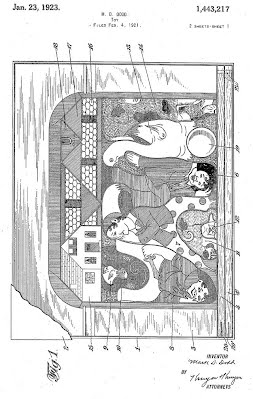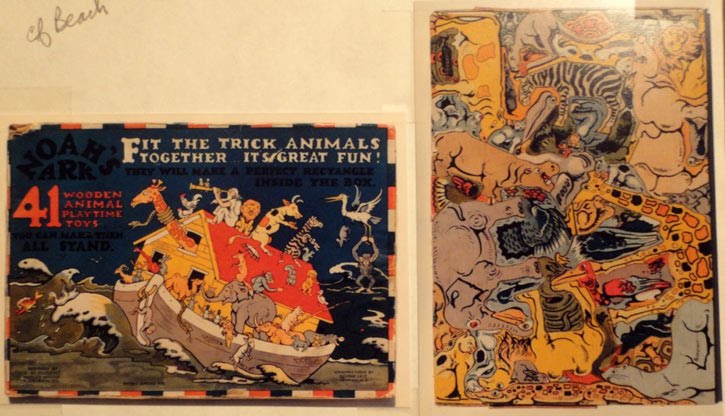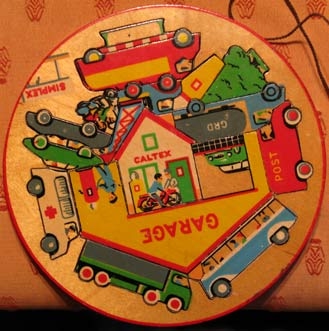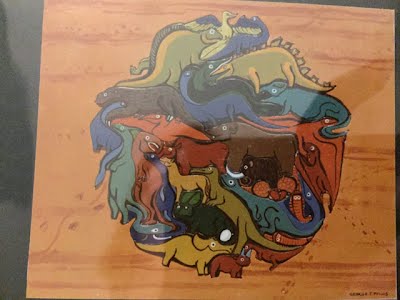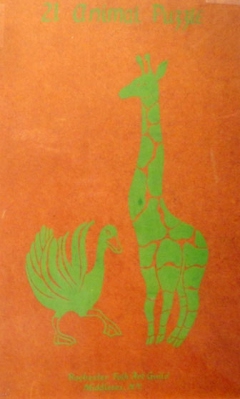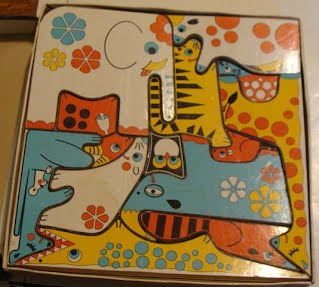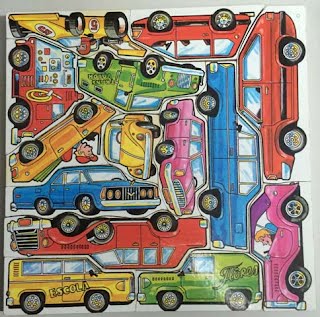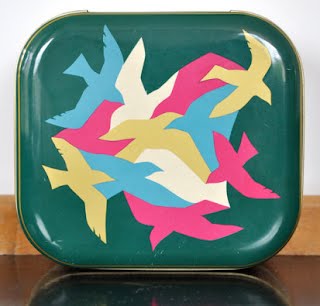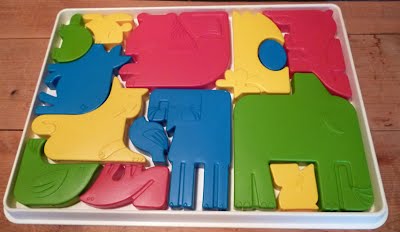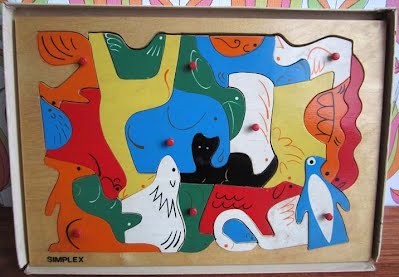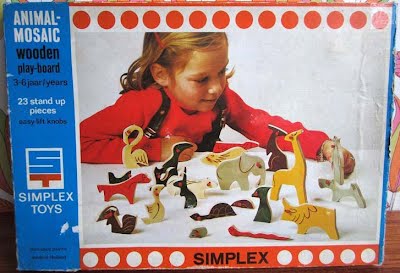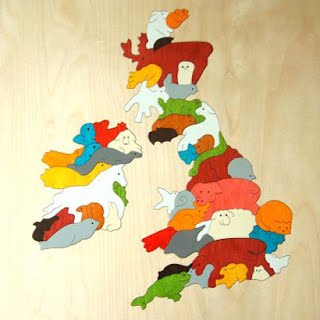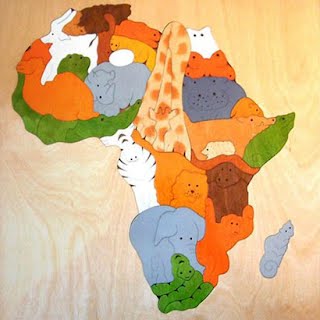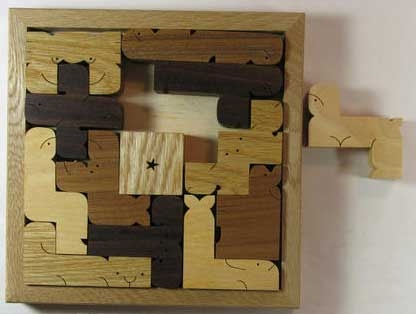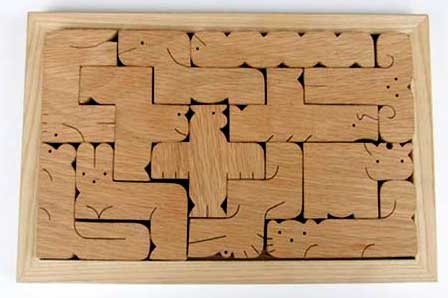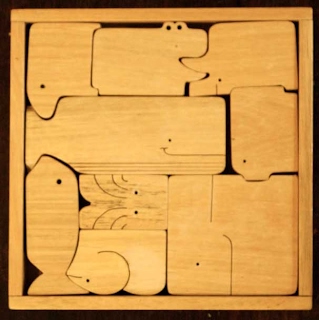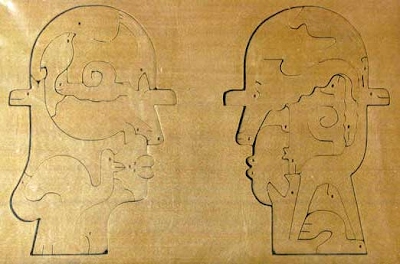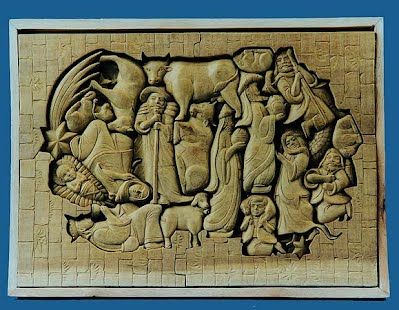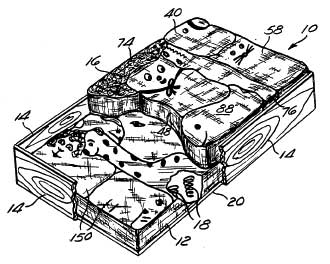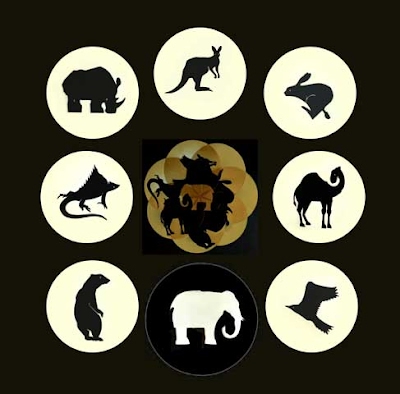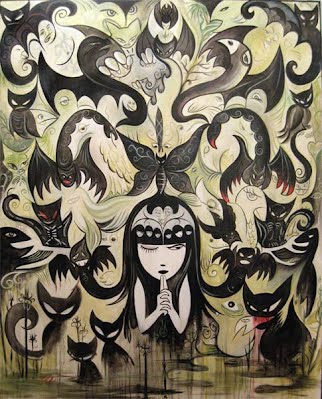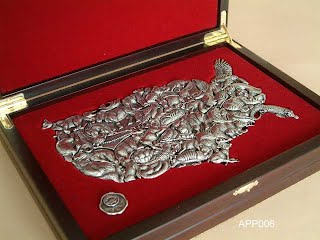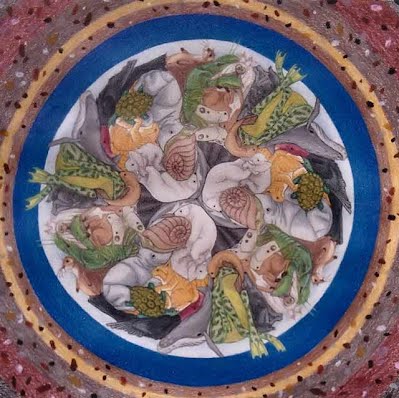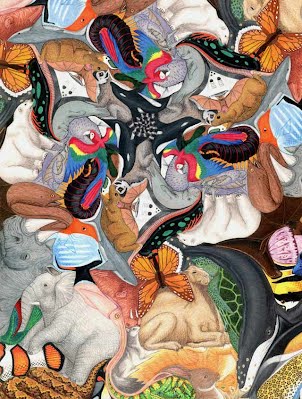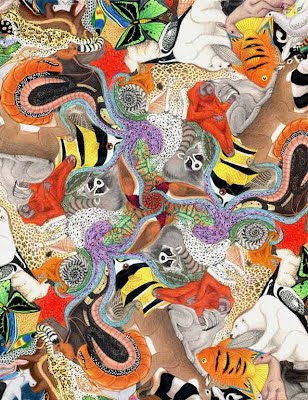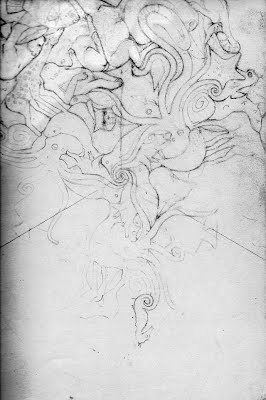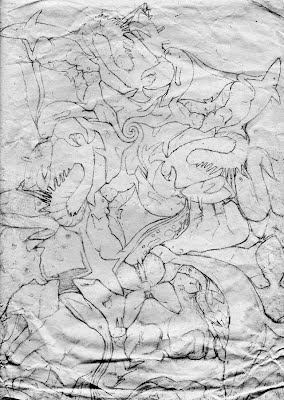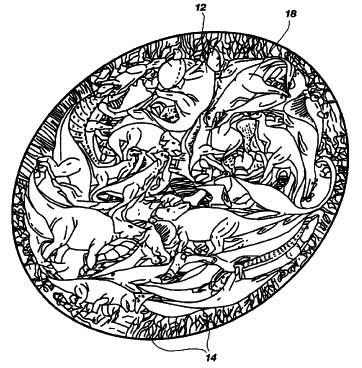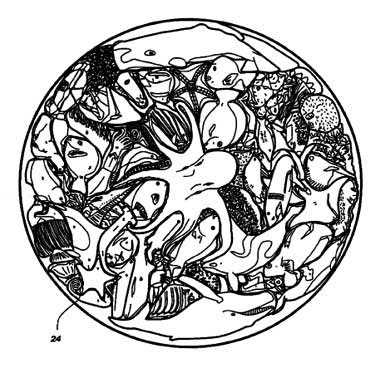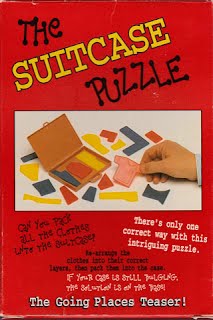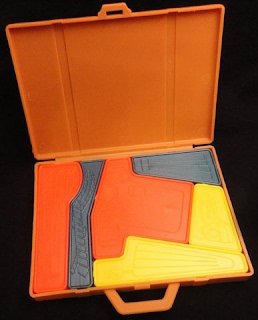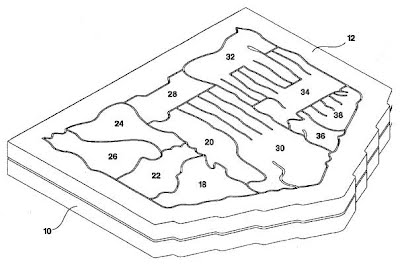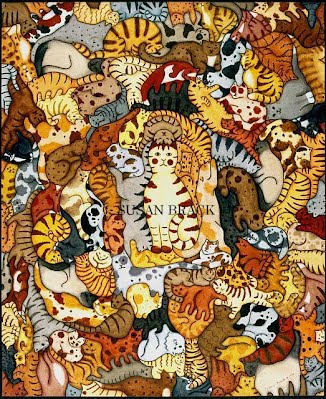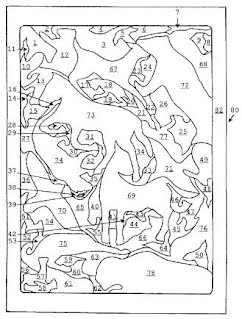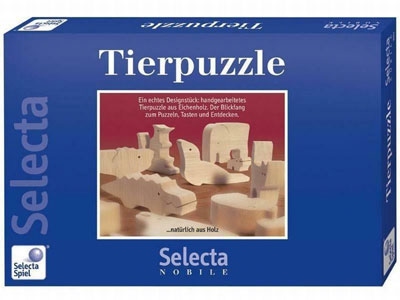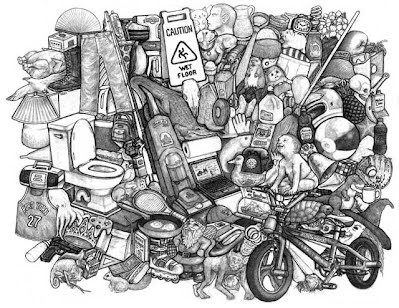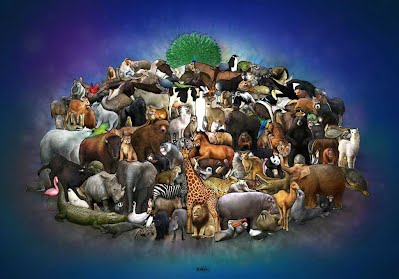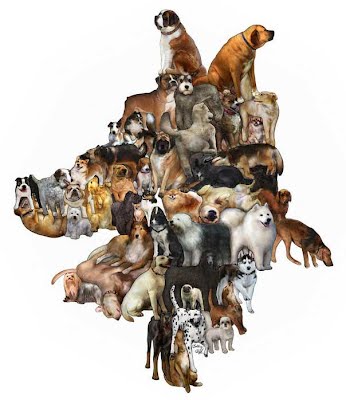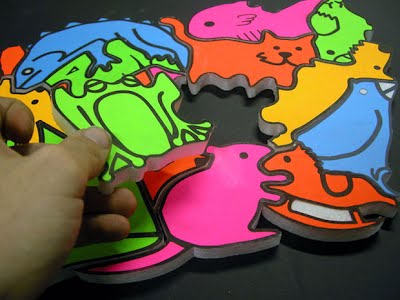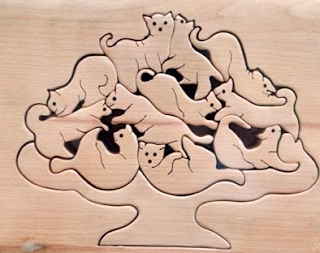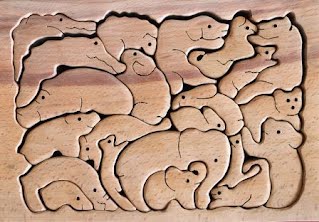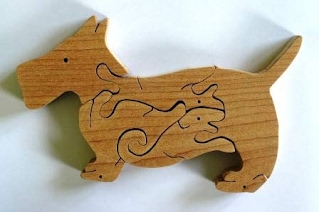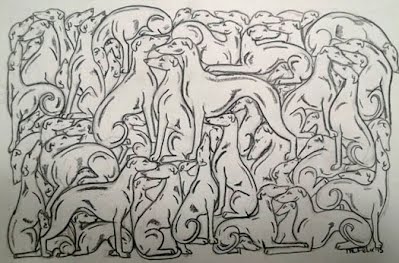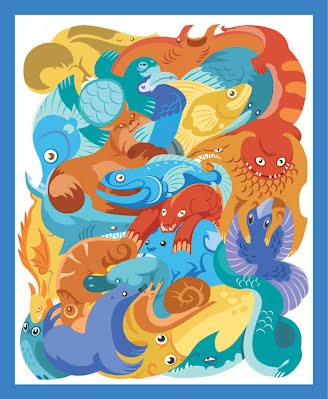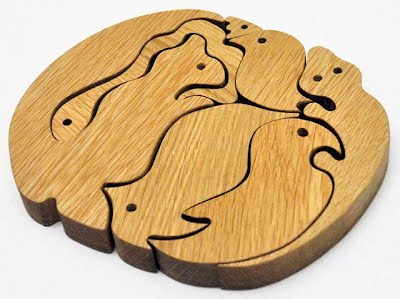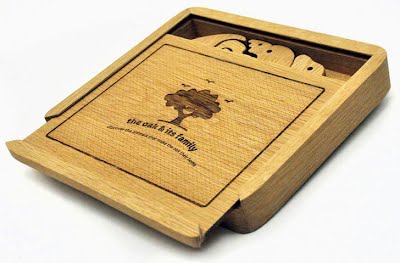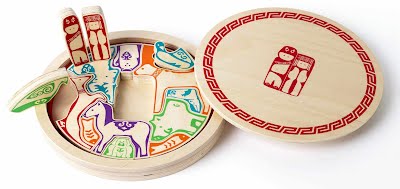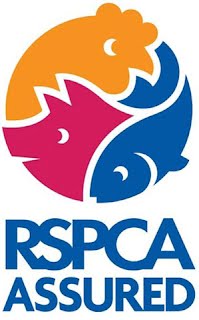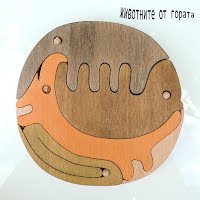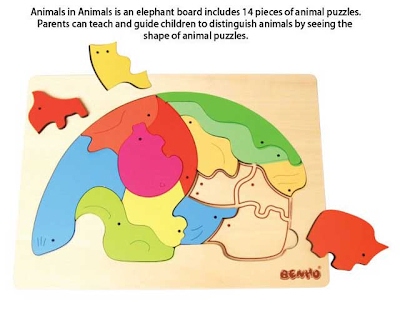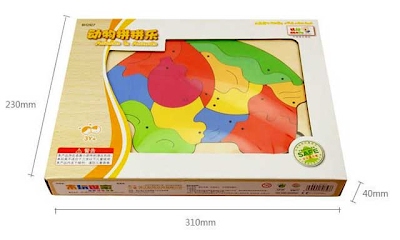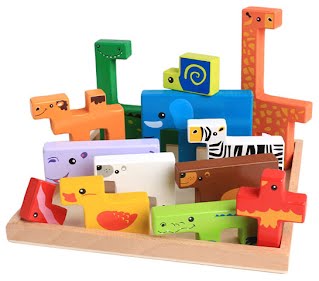Introduction First, what exactly is a ‘cluster puzzle’ tessellation? From this bare description alone, the premise is not at all obvious. Simply stated, these pieces can be described, in jigsaw terminology (of which genre these are generally to be found), of ‘every piece a picture’ that is, each piece is of a (ideally) whole real-life figure, such as an animal, or object. Ideally, these are of many different individual pieces so that a jigsaw like appearance is obvious. Contrast that with a ‘normal’ jigsaw, where the piece is only a very small part of the picture. However, this can also describe a ‘normal’ tessellation. The difference here is that the tiles do not repeat in any way. Cluster Puzzle Derivation Forerunners
Of the Alex Palmer model, there are both forerunners to the genre and earlier instances. Indeed, there are as many as nineteen earlier instances by artists that equate to his work. However, detailing forerunners is not always a straightforward task, in that the format and tessellation principle is loosened somewhat, with gaps and overlaps, to greater or lesser degrees, in that what the artist is intending is vague and unclear. Indeed, some here are so weak indeed, that they are of dubious inclusion. However, on the premise of ‘leaving no stone unturned’, I thus include ‘all’ forerunners, no matter how tenuous at times, of which I at least document these. Specifically, there is some extensive artwork that bears the semi-official title of ‘composite animal art’, of essentially animals within an overall animal outline. The genre has been discussed in academia, notably by Armen Tokatlian, and others. In short, composite animal art originated in the Islamic world from the east sometime in the 14th century. The first extant instance is a ‘cloud band’ in one of the well-known Fateh albums that is composed of humans, fish, elephants, boar, lions, cattle, leopards, jackals, kylins* and a dragon, the whole cloud resembling a dragon in its serpentine form (Topkapi Saray Library, Istanbul, H.21530). However, perhaps more than most here, this is tenuous in relation to a tessellation premise; considerable overlaps and gaps are to be seen. There seems to have been a surge in the popularity of composite animals in the late 16th and early 17th century, for a considerable number of such works survive, executed in Persia and India, with Khurasan producing the most. Especially featured are elephants, and camels, where they are revered in the culture. In a similar vein, the Japanese artist Utagawa Yoshifuji (or Yoshifuji Utagawa) (1848–1849) has two works, featuring cats, ‘The Supernatural Cat of the Tokaido’, c. 1847 and ‘The Head of the Cat-witch of Okabe from the Fifty-three Stations’ (there appear to be variations in the title). Echoing the Indian revere, cats are likewise culturally revered in Japan. Of note is that all these works are artworks, rather than as puzzle pieces. Aside from these instances of essentially animals within an overall animal outline, there is also the work of John Sloan (1871–1951) who of April 14, 1901, published 'The Blackbird Puzzle' in the Philadelphia Press newspaper. The puzzle was predicated on the nursery rhyme ‘Sing a song of sixpence a pocket full of rye, Four and twenty blackbirds baked in a pie’, of 24 black birds within a stylised pie. However, the premise here of a double contour line throughout is noticeably weakened to greater or lesser degrees. However, the graphic still remains cluster puzzle in intent, if not ideally so.This is perhaps truer to the ‘standard model’, albeit still with reservation; even here this is still not a true representative of the strict interpretation here, as it has ‘introduced definitions’ and with many gaps (in relative terms) but is getting closer. Incidentally, Sloan was a well-known painter of the twentieth-century Ashcan school of American art. Further, he had a puzzle bent, as between February 18, 1900, and January 11, 1903, he produced for the Philadelphia Press more than 125 full-page puzzles, with a $10 prize, incorporating hidden words or images, pictorial puns and components that required cutting. However, this instance is his only known work in relation to cluster puzzles. One artist of possible connection I have excluded is Arcimboldo (1526 or 1527–1593), an Italian painter best known for creating imaginative portrait heads made entirely of objects such as fruits, vegetables, flowers, fish and books. In short, these lack a double contour premise of a tessellation, being rather objects bundled together, that to me at least are out of the remit of the cluster puzzle premise. * A kylin is (an animal in ancient Chinese mythology. It is somewhat like a deer, with horns on the head and scales over the body. Its tail is like that of an ox's. The kylin is said to be an animal of longevity that could live for 2,000 years. Escher’s Contribution Of note is that the master of life-like tessellations, M. C. Escher himself tried his hand at instances of this type, with two instances, separated by six years; Plane Filling I (PD 83) of 1951 and Plane Filling II of 1957 (numerous books on Escher show this). Escher described these as ‘Free plane fillings, based on rectangular system, with 36 different motifs. Design for a mezzotint’. Incidentally, note that Plane Filling II has been produced as a jigsaw with individual pieces by the Iproject company. As an aside to this, Doris Schattschneider, in Visions of Symmetry p. 306, relates a letter from Escher of 1963 to George J. Paulus, an American architect, in which Paulus sent Escher examples of his own work in this field, to which Escher replied ‘You are the first who shares my secondary hobby for irregular filling’. From this, it is clear that Escher had no inkling of the numerous predecessors in this field.
As can be seen from the chronological listing, the earliest instances are spasmodic, with for instance no less than fourteen years between the first (Richardson) and second instance (Dodd). Such spasmodic instances occurred subsequently throughout the following decades: 1930s (Eagle-Clarke), 1940 (Schoonderbeek, Paulus, Hahn) and 1950s (Escher, Mari), with just a handful of instances. However, in 1960s (Palmer), they began to increase in frequency. That said, this is in relative terms; even as late as the 1980s (Wright) there was but just two instances. Subsequent to that decade, the concept seems to have become more and more popular, although likely most are independent ‘discoveries’ of the genre. Certainly, upon correspondence with latter day designers, they are generally unaware of the history. Format and Premise Themes Japan Faux Cluster Puzzles The term ‘cluster puzzle’ can also be applied to other puzzles of what at first glance appear to be bona fide cluster puzzles, but upon closer inspection be seen to fail, and of which I so title as ‘faux’, but perhaps not evident to the tyro, and so false appreciation may be awarded. Note that this should not be though of as a criticism of the designers below, as almost certainly they were not setting out to produce a bona fide cluster puzzle, but rather had their own agenda. Three different types are identified:  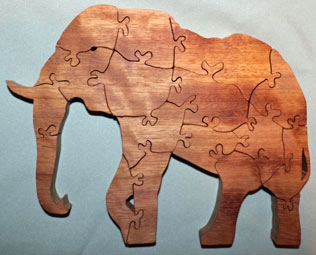 Faux Cluster Puzzles: (i) Overlapping, (ii) Close amalgamation and (iii) Outline puzzle with abstract pieces Medium The medium varies too. Seen are ‘traditional’ jigsaw puzzles, of both cardboard and wood, these being the most frequent, but also plastic, drawings, silverware and bakeware. Some of the pieces in wood are designed to be as playthings in their own right, and can be stood up. Background Detail of Designers As can be seen from the examples below, this type of puzzle is now over a century old, and typically, especially so for some of the earliest examples, background details as to the designers, and indeed the puzzles themselves are decidedly lacking, which is only to be expected given the passage of time. I would be pleased to receive any further details of the puzzles themselves, and/or their designers, no matter how small or insignificant it might thought to be.
Research Difficulties Note that as some of the puzzles are extremely old, and so hard to obtain (indeed, if available at all), I do not always have these in my possession to examine. Without the puzzles always to hand, assessing these is not always straightforward. For instance, counting the number of distinct pieces from pictures is not always a straightforward task as it might appear, as in discerning the individual elements of some, especially of the photographic type renderings, of the motifs tend to merge. Consequently, on occasions, the number of pieces is prefixed with ‘about’. The research here is primarily web based picture searching, aided by contacts in the field, mostly from the jigsaw puzzle community.
Listing Desirable Features The puzzles seen differ widely in regards as their degrees of inherent quality and style, and so consequently, assessing their aesthetics is not a straightforward task. All these aspects combine to make a cluster puzzle of merit (or otherwise!). Just as in life-like tessellation, the quality varies immensely, generally caused by a lack of understanding of the issues. These aspects I now discuss in a little more detail (more exact details can be found in my series of essays): A desirable listing, in a rough order of importance, includes:
1. Compelling silhouettes (rather than inferior ‘surface decoration’) This issue is at the crux of the matter, and can be considered as the litmus test, with all other aspects, in relative terms, paling to this aspect. Simply stated, in isolation, as a silhouette, the figure should be immediately recognisable. A formless shape, reminiscent of nothing in particular, no matter how good the surface decoration may be, is simply not acceptable. Just about any shape can be rendered as ‘life-like’ with the addition of a dot for an eye, without any other detail. However, this misses essence of design, of being recognisable in silhouette. Such instances can be considered as mere surface decoration, requiring no skill.
2. Whole bodied motifs or whole objects (rather than easier ‘heads’ or amputations) As a general statement, ‘whole bodies’ or whole objects, i.e. of the entire motif are to be preferred, as against what I term as ‘amputations’, such as ‘heads’, as by their nature the latter are inferior, being easier to accomplish, as the greater part of the body is dispensed with. (Note that Escher’s two instances as detailed above are all this type.)
3. Tight interlocking, without gaps or overlaps (rather than large to minimal ‘wriggle room’, and overlaps) Ideally, the pieces should not require ‘wriggle room’, as this destroys the principle of tessellation, of a line of a double contour purpose, with a line representing two aspects of a motif at once. Also, there should be no overlaps, this again destroys the principle of tessellation. Some artists take considerable liberties here, with both aspects, indeed too much. Where possible, one should adopt the high moral ground, i.e. no wriggle room, no gaps, whatsoever, and certainly not large expanses of space or excessive overlapping.
4. True-to-life animals or objects (rather than easier to achieve ‘whimsies’ or ‘fantasies’) True-to-life animals, or objects, are much to be preferred. In contrast, other categories, such as ‘whimsies’ or ‘fantasy figures’ have considerable more leeway in outline, and so lack challenge. In addition, the motifs should ideally be proportionate.
5. Themes (rather than a disorderly collection of arbitrary animals, and objects) Ideally, for the sake of consistency, a general theme is considered best, such all the pieces being of human figures, all animals, all inanimate objects, or whatever. Alternatively, for even more of a challenge, all of a single motif, such as all cats (as by Susan Brack and A. K. Dewdney). Without a theme, the composition can appear a little disjointed.
6. M. C. Escher styles of portrayal for easier identification of motifs (rather than photographic realism, in which the individual motifs tend to blur) Various possibilities arise as regards styles of portrayal of the motif in question. In increasing order of complexity: without interior design, interior line design, cartoon, a photorealistic portrayal. Related is colouration. Ideally, the individual pieces of the puzzle should be readily identifiable, the eye should not have to ‘struggle’ to make out the motifs. What is ‘best’ is thus subject to debate. In themselves these are all fine. However, as alluded to in 1 above, for a given silhouette, with the unique feature of tessellation, of a figure ground principle, the portrayal should be one that results in the motif being readily identifiable, at-a-glance. to this end, I consider that Escher had the right approach, these being balanced in the centre, certainly not photorealist, nor minimal. In this regard, the works of Escher serve as the exemplar. If a photographic rendering is tried, typically this is too detailed, with definition of each motif lost. In short, the portrayal should echo Escher’s, although as this is a matter of teats, I am not too dogmatic here.
7. Motifs upright (rather than a ‘disorderly’ collection in a variety of orientations) As a general statement, upright motifs are to be preferred rather than upside down, or at an unlikely angle, all of which jars against the senses (again, Escher railed against such instances in his writings, calling these ‘absurd’ [6] page 77; of note is that in Escher’s two instances the motifs are upright). However, in the context of cluster puzzles, this can be overlooked, given the difficulties involved. Certainly, I am less dogmatic here than in other categories.
8. Large number of motifs (rather than of just a small number of motifs) Ideally, the composition should be of a substantial or ‘large’ number of motifs, arbitrarily stated. I have seen instances from just two pieces (Oguru) to a nearly a hundred pieces (Richardson), with a typical average of 20-30. It stands to reason that all things being equal (which is not always so), an instance with large numbers is more praiseworthy than that of fewer numbers. Consequently, if for a given puzzle the pieces are of about equal degrees of quality, a puzzle with more pieces is more worthy of praise, say 24 piece is better that a 12, a 36 over 24 etc. Furthermore, the few in number largely do not have to address themselves with double function of line, as at the borders one can have free reign, with no ‘central pieces’ to take into account. To put figures on the above, I would consider a 10 piece puzzle to be a bare minimum, with 20 or higher pieces more desirable.
That said, there may indeed be occasions on which these guidelines in the context of cluster puzzles may be freely broken. Achieving a cluster puzzle that is of compelling silhouettes, is of whole-bodied motifs, is true-to-life, is themed, has all motifs upright, is of a large number of pieces, of no wriggle room or overlaps and is of M. C. Escher style rendering is a Herculean task! Indeed, I know of no such instance of an ‘ideal’ cluster puzzle. And likely to even ask or to aspire is simply impractical; the demands of the premise are simply too great. An analogy, as George Orwell said in connection with matters of grammar with his famous sixth rule: ‘break any of these rules sooner than say (do) anything outright barbarous’. The same policy should be adopted here. Of course, although this is the ideal to aim for, as might be imagined, such an ideal cluster tessellation is asking a lot of the designer! Consequently, where otherwise one should be critical of such inferior elements as described above appearing in a ‘normal’ tessellation, to a certain extent these can be overlooked in these circumstances.
Upon having given a broad history and a discussion of what constitutes a good cluster puzzle, I now list the individual puzzles in more detail, in chronological sequence, upon which I discuss individually under each designer:
Chronological Listing of Designers:
1909, Two uncertain newspaper reports Bona Fide 1920s (3) 1930s (2) 1940s (5) 1950s (3) 1960s (8) c. 1960s, Kolibri, one commercial wood jigsaw puzzle, of animals c. 1960s, Estrela, two commercial puzzles, of animals and cars c. 1960s, Rochester Folk Art Guild, Animal Puzzle 1960-1967, Alexander D. Palmer, Cadaco cardboard jigsaw puzzles, figurative motifs 1963, Dave Lyons? Crowded Car Illustration from ‘Count the People’ puzzle, Humpty Dumpty magazine 1964, David Ashe, Nativity themed scene, in Better Homes & Garden magazine. 1967, Lakeside Toy company, anonymous designer, a series of six plastic puzzles: 16 Trains & Planes, 18 Horses & Riders, 19 Animals, 20 Cars and Trucks, 21 Fish & Birds and 25 Ghosts. 1967, University Craftsmen Inc. Two wooden puzzles, of zoo animals and trains 1970s (11) 1980s (10) 1990s (14)
2000s (14) 2010s (14) Unknown (35) Frequency listing by decade: 1900s (1) 1910s (-) 1920s (3) 1930s (2) 1940s (5) 1950s (5) 1960s (5) 1970s (11) 1980s (10) 1990s (13) 2000s (13) 2010s (14)
The Designers All these aspects combine to make a cluster puzzle of merit (or otherwise!). Just as in life-like tessellation, the quality varies immensely, generally caused by a lack of understanding of the issues. These aspects I now discuss in a little more detail (more exact details can be found in my series of essays): Precursors: 1848-1849, Yoshifuji Utagawa, ‘The Supernatural Cat of the Tokaido’, drawing Yoshifuji Utagawa (1828-1887), a Japanese artist, between 1848-1849 created a series of ‘puzzle pictures’, somewhat reminiscent in style of the Italian artist Giuseppe Arcimboldo, who was best known for creating imaginative portrait heads made entirely of objects such as fruits, vegetables, flowers, fish, and books. However, this is indeed a likely an independent idea conceived by Utagawa who was likely unfamiliar with his work, as Arcimboldo only came into prominence in the 20th Century. In Utagawa’s instance, a conglomeration of cats in various poses made up various human heads. However, strictly, these are not of a cluster puzzle, or at least of the higher classifications, as there are indeed overlaps. However, one of these in particular ‘Gojusantsugi no uchi neko no ayashi’ (The Supernatural Cat of the Tokaido) is perhaps of more relation to the genre than others, albeit it is still far from an ideal nature. Nonetheless, there is a broad element of a double contour line. Of the print, note that the eyes are bells and the mouth is a thick red ribbon of the type Japanese cats wore. Note that the choice of cats as motifs is no accident. In short, they are revered in Japanese history, and so thus a natural subject for Japanese artists per se, and so Utagawa thus simply follows in this tradition. Can anyone add to what is given above? In particular, I would like to know more about the background to these ‘puzzle pictures’. An open question is whether Utagawa was indeed unaware of Arcimboldo’s work. This is my own supposition. As ever, no detail is too small to mention. Further, with all the difficulties involved in researching in a foreign language, some of the above is perhaps more subject to revision than other more certain researches; I stand to be corrected.  The Supernatural Cat of the Tokaido 1903, John Sloan, forerunner 'Blackbird' John French Sloan (1871-1951) was a well-known painter of the twentieth-century Ashcan school of American art. Aside from this, he seems to have had a puzzle bent, as between February 18, 1900, and January 11, 1903, he produced for the Philadelphia Press more than 125 full-page puzzles, with a $10 prize, incorporating hidden words or images, pictorial puns and components that required cutting. Of the various puzzles, one of these can be termed as a forerunner to cluster puzzles, with ‘The Blackbird Puzzle’, of April 14, 1901. The premise here was of packing birds in a pie based on the well-known nursery rhyme. However, the premise here of a double contour line throughout is noticeably weakened to greater or lesser degrees. However, the graphic still remains cluster puzzle in intent, if not ideally so. Newspapers, 1909 Intriguingly, there are two early accounts in newspapers that by their description alone seem to indicate a cluster puzzle, albeit infuriatingly they are not pictured and are without a credited designer. First, the Aberdeen Press and Journal on December 2 1909, in which the Duchess of Manchester has possession of a 2600 piece puzzle and *** Bona Fide Puzzles c. 1909, Margaret Richardson/Mrs Hayden Richardson. N.B. For greater detail on this entry, see the dedicated sub page. Puzzle inventory, in chronological order, with dates and number of pieces: This puzzle is noteworthy on different accounts; the first apparent instance, and the most number of pieces. The background to the designing of the puzzle is unknown, as indeed of Richardson. The only background detail I have of her is that she was a jigsaw puzzle designer, between 1908 and 1910, and is of New York City [1]. Richardson was quite well known in the jigsaw puzzle community, with other, ‘standard’ puzzles; but it would appear that this is the only instance of tessellation that she did. Not themed; a large and wide variety of living creatures are portrayed, from strict likeness to whimsies; however, the whimsies are few in number, and largely inconsequential. As such, the quality varies, between instantly identifiable, and not. No concession is given to orientation concerns, with the motifs appearing ‘every which way’ something of which subsequent artists address. Of note is the large number of pieces, 90, the largest so far. As detailed above, as a rule this is more worthy of praise, all things being equal. © Bob Armstrong Satirical Maps, 1914 Puzzle inventory, in chronological order, with dates and number of pieces: Although perhaps not strictly not a cluster puzzle in intent, what is termed as ‘Satirical Maps’, popular in 1914 at the outbreak of the First World War, undoubtedly have a relation to such matters, and so I thus include here. The genre draws upon national symbols and stereotypes, such as a British bulldog, Russian bears etc., with each figure broadly filling out their respective country outline to greater or lesser degrees. The best as regards cluster puzzle/tessellation matters is probably by Louis Raemaekers, of the Netherlands, titled ‘Het Gekkenhuis’, translated approximately as ‘The Lunatic Asylum’. Raemaekers was an artist of some renown, said to be the best-known propaganda cartoonist of the First World War (although I was previously unaware of him). This is the only ‘tessellation’ instance of his I have found. His work was apparently common knowledge in the Netherlands, and indeed worldwide. As an aside, it would be interesting to know if Escher knew of this particular work. I am unfamiliar with any reference in this regard. Some other instances of note of the genre, but by different artists, are ‘Humoristische Karte von Europa im Jahre 1914’ and ‘Satyrische Europa Karte’. Het Gekkenhuis   1923, Mark D. Dodd Puzzle inventory, in chronological order, with dates and number of pieces: Mark Dixon Dodd (1888-1952) originally of New York City, in the county of the Bronx, and later St. Petersburg, Florida, USA, has a 1923 patent, simply described as of a ‘toy’. Historically, this is of some significance, being the first patent and second such puzzle instance per se. The puzzle consists of children at play and farm animals and a few inanimate objects, such as a house, kennel, fence, trees and ball. Telling is Dodd’s text, where he states: c. 1930, 1933, Arthur W. Nugent Puzzle inventory, in chronological order, with dates and number of pieces: Arthur William Nugent (1891-1975), better known as Art Nugent, created at least three cluster puzzles, c. 1930 and 1933, although he was not primarily a jigsaw puzzle designer/maker. Rather, he was a cartoonist and children’s puzzle designer for the Funland comic, notable for his long-running syndicated puzzle features (also known as Uncle Art's Funland), which he drew for four decades, with games, riddles, connect-the-dots art, crossword puzzles and anagrams. However, as far as I can ascertain, none of these featured cluster-type artwork. © Anne Williams © Anne Williams1931, Arnold G. Dana Puzzle inventory, in chronological order, with dates and number of pieces: 1934, Mrs Elspeth Eagle-Clarke N.B. For greater detail on this entry, see the dedicated sub page. Puzzle inventory, with title, dates, number of pieces and dimensions: 1. ‘Dragon’s Land’, of 81 pieces, 1934, 15½” x 17” Elspeth
Eagle-Clarke (1888-1969), of the United Kingdom was a
talented amateur artist who designed at least two commercial cluster puzzle
instances (and possibly two others) for the Chad Valley company, titled
‘Dragon’s Land’ and ‘Elfin’, both likely of 1934. The puzzles are historically significant, being just the fifth such instance
and the third patent granted. As alluded to above, note that the two known puzzles
are qualified by the possibility of three more instances. Dragon’s Land and Elfin
1942-1947, W. Hahn Puzzle inventory, in chronological order, with dates and number of pieces: W. Hahn, a Dutch puzzle maker/designer created two cluster-type puzzles (albeit with reservations) from c. 1942-1947 (as told to me by the Dutch puzzle authority, Geert Bekkering). These are somewhat alike in style to those of the Simplex company, of a like date, although whether this is coincidence or not is unclear. Assessment: 1944 Mme. Trias and M. Angel Lescarboura Puzzle inventory, in chronological order, with dates and number of pieces: Mme. Trias and M. Angel Lescarboura have a 1944 French patent numbered 893.550, titled ‘Nouveau jeu d’assemblage (puzzle) en boisou matières plastiques’, translated as: 'New puzzle game made of wood or plastic’. This is of note as the first non-US or UK instance, and first (and only) known French patent. Historically, this is of significance, being the fourth such patent instance. 1945-1955, Simplex company, Netherlands N.B. For greater detail on this entry, see the dedicated sub page.
Puzzle inventory, in alphabetical order, without dates and number of pieces (dating these exactly is not possible, as they are not individually denoted): 1. Boats 4. Cowboy First, what is known of the company is largely due to the sterling efforts of three people: Betsy and Geert Bekkering, who wrote about them extensively in their book on Netherlands jigsaw puzzles [1], Nico Stalenburg, a Simplex enthusiast [2], and a local community website [3], and of which the details below is an amalgamation taken from the above. However, there is indeed a degree of originality, of which I enquired with George Escher, Escher's son, as to what, if anything, they knew of the puzzles. The Simplex company, at Aalst near Eindhoven of the Netherlands, under the direction of Mr F. J. van der Vlugt and a little while later Mr H. A. W. Steinmeier, from 1945-1955 produced a limited range of cluster puzzles in intent. However, this is with considerable reservation, as none of these are ideal examples of the genre, and indeed at time barely qualify, and furthermore such examples were very much a small, insignificant part of a large scale production of children’s puzzles in general. Simplex was for a few years after the Second World a household name in the Netherlands, and of which for many Dutch children made a welcome game. Indeed, in most houses you could find them. A common feature is that of a circle format, albeit with an occasional rectangle. The choice of a circle format was dictated to by the materials to hand. These are in fact made from ‘waste wood’ from the Phillips radio screens. These were then used these to make dolls furniture at first. It was an English officer who suggested making them into round jig-saw puzzles. The cluster puzzles were very much part of a small remit, and ceased after 1955, albeit the more traditional puzzles continued. Whether there was a single or multiple designer of the cluster puzzles is not clear. Furthermore, it is not possible to put an exact date on any one puzzle. The company was certainly prolific, with production runs of millions a year. Indeed, the marked was soon flooded with circular puzzles and they stopped producing them in 1976. Indeed, they are widely available to this very day on auction sites. The puzzles bear the occasional titles ‘Cowboy’, ‘Circus’, ‘Train’, ‘Buildings’, ‘Ships’ and ‘Garage’. Of interest with the Simplex puzzles is of whether M. C. Escher knew of them, and if so did they influence his own works in this field, namely of Sun and Moon, Plane Filling I and Plane Filling II, which were undertaken subsequently, in 1948, 1951 and 1957 respectively. Escher in his writings never mentioned Simplex. To this end, I then contacted George Escher [4], his son, for any possible thoughts on the matter. In a mail he told me: From this, it would thus appear that the Simplex instances had no influence on his work. As to the puzzles themselves, the weakness of these as regards inherent quality can be seen by observing the puzzle in reverse. For instance, ‘Circus’, bears no resemblance to an even half recognizable motif! All the artist has largely done is draw interior detail inside an arbitrary boundary. There is no skill here whatsoever. The same principle applies to the others, to equal or lesser degrees. Note that subsequently, in 1972, Simplex, produced more cluster puzzles, but of a completely different kind, in which the inherent quality is much better. Likely, this was a Fisher Price influence, the company having been taken over by them in 1970. Furthermore, these are of a different format, with more numerous motifs, and can only have been designed by different designer. These are discussed separately, under 1972. Assessment: Type C puzzle (the lowest), of typically 10-12 pieces, a noticeably low number. However, these are at least themed, albeit in this instance the lack of articulation makes such matters of little consequence. The puzzles invariably have issues with silhouettes and articulations, and are sadly all too lacking, and so consequently these are some of the poorest examples to be seen. Selecting a best here is an onerous task, as they are all of a par, of such poor quality. As ever here, does anyone know of further details of the above? No detail is too small to know.
References: © Geert Bekkering 1946, Jacobus Hendrik Schoonderbeek, Animal Puzzle Puzzle inventory, in chronological order, with dates and number of pieces: 1. Animals, 13 pieces, 1946 Jacobus Hendrik Schoonderbeek (also known as Jac. Schoonderbeek) (1894-1945) of Den Haag, the Netherlands, has produced a single known cluster puzzle, themed, of animals, in wood, apparently for children, and patented in three countries, detailed below. However, much remains unknown of this puzzle, It is barely mentioned or indeed pictured in the literature. The only references are a brief discussion and picture of a Swiss patent, as an aside, in Palmer, p. 13, and a single pictured reference on the Kolibri puzzle website, and of which that itself was misattributed! However, there are three known patents, of the Netherlands (referenced, but not seen) of 1943, Switzerland and France, of 1946, which does indeed give more detail. And indeed, little is known of Schoonderbeek himself, perhaps thwarted by him flourishing during the war years. However, what is know is that Schoonderbeek can be described as a board game manufacturer and puzzle designer/producer, with board games Beursspel, Molbo, Tante Pos, and Larkenbelt to his name. Note that in the following text in brackets this is the English translation (Fairplay …) albeit exactly which of these was by himself is unknown. Further to puzzles, there are four known jigsaw puzzles by him, ‘Nederland Herrijst’ (Netherlands Reigns) and Geallierde Vlaggen Chr Suinninghe Damaste (Allied Flags), a still-life of 910 pieces and curiously a cluster puzzle in which W. Hahn is credited as the designer. He registered the company name U.S.N. which in full is Uitgeverji Schoonderbeek Nederland (Publisher Schoonderbeek Netherlands) and which was also used on other puzzles. Indeed, with an instance of the genre by Hahn, it is by far from certain that the cluster puzzle is by him, although it would indeed appear so. That by Hahn and presumed by Schoonderbeek are notably different in style. An open question is how widely produced the cluster puzzle was. Did it appear in Switzerland and France as well as the one confirmed instance in the Netherlands? 1946+, George J. Paulus, Various Puzzles N.B. For greater detail on this entry, see the dedicated sub page. George J. Paulus (1910-1995), was an American architect, with an interest in Escher-like tessellations (and who corresponded with Escher), has composed numerous cluster puzzles, titled ‘Paulus Puzzles’, many with themes. Paulus, along with others (in alphabetical order), such as Angiolo Logi, Alex Palmer, and Götz Peter Reichelt can be described as major names in the field, of which to fully better document their more substantial works in the field have dedicated pages, replete with imagery, aside from the initial entry here (to appear). c. 1950s, Aymara Indian Nativity Scene Puzzle inventory, in chronological order, with dates and number of pieces: A nativity-themed puzzle, from the Aymara Indians, an indigenous people (population one million) from South America, of Lake Titicaca, on the border of Bolivia and Peru. This was hand-painted in their own likeness, and made of clay (a unique instance). The puzzle is of some considerable interest, in many ways. However, much background detail remains unknown, and likely will remain so, for a variety of reasons, such as an obscure location and rarity (of only one known instance), and without any leads to pursue. The puzzle was found advertised on the Artfire.com site and described as below: This unbelievable nativity in clay is constructed as a puzzle. The parts will stand independently or place in box for scene that fits just as a puzzle. You can see the Bolivian Chullo Hats, the Bowler hats worn by the women, and the baby Jesus small cap. I love the animals that show the area of the country - the llama, chicken, lambs, bull, goats, water jugs, all the vegetation. The clothing, faces and colors depict the Bolivian culture of the Aymara Indians. Unfortunately, for various reasons too detailed to mention here, I was not able to contact the seller for further details. The year given, c. 1950, is stated to be an estimate. I would not be all surprised if this was wrong by many decades; there is no indication on the puzzle itself on which to base this date. Details are at a premium, there does not appear to be any accompanying details on the box or a leaflet; the designer’s name is not stated. Whether this is a ‘one-off’, or mass-marketed to tourists is not clear. Background matters aside, these are of a reasonable standard, of no gaps, but certainly not of the highest standards, nor of the lower ratings. It has a relatively high number of pieces, 24. As with other puzzles, this has a dual purpose, as a puzzle in its own right or as a plaything.
Can anyone add to what is given above? In particular, I would like to know of the designer’s name and the date. As ever, no detail is too small to mention.
1951, M. C. Escher N.B. For greater detail on this entry, see the dedicated sub page. Puzzle inventory, in chronological order, with dates and number of pieces 1. Sun and Moon, 1948, 24 motifs 2. Plane Filling I, 1951, 36 motifs 3. Plane Filling II, 1957, 40 motifs Maurits Cornelis Escher (17 June 1898–27 June 1972), the life-life tessellation pioneer who scarcely needs a further introduction, shows three cluster puzzle instances (although of course not known by the title of the day), with Sun and Moon, with 28 (bird) motifs, of 1948, Plane Filling I, with 36 animal motifs, of 1951 and Plane Filling II, with 40 animal motifs, with one exception, of 1957. As suggested by the different names, these differ in style, and from two broad subgroups. Plane Filling I is also shown as a periodic drawing, No. 83. The Plane Filling works are also synonymously titled Mosaic I and Mosaic II. Given that ‘Plane Filling’ is generally preferred, I thus use this title below. Of note is that despite the three works all being of a cluster puzzle nature, they all differ subtly in their respective approaches. Of note is that all instances are of the higher standards, of whole-bodied motifs, with generally good articulations, and furthermore all upright, or mostly so, and not of the lower quality ‘amputations’ and as used by others above. They are all rendered to a high quality, and do indeed have contrast, and so are readily identifiable, something which is generally lacking in others. Of note is that all three works consist of a variety of animal and human-like forms, some instantly recognisable and some of an extremely fanciful nature. However, there is one exception, where a non-animal motif is included, namely a guitar, in Plane Filling II.
1957, Enzo Mari N.B. For greater detail on this entry, see the dedicated sub page. Puzzle inventory, in chronological order, with dates and number of pieces: 1. 16 (Sedici) Animali 16 pieces 2. 16 Fish (Pesci) 16 pieces The Italian designer Enzo Mari (1932- ) who in 1957 made contact with the Italian plastic products manufacturer Danese and agreed to develop a series of mass-manufactured products, and not just cluster puzzles. Specifically, germane to this page, he designed two wooden puzzles, of 16 pieces each, of two themes, of animals and sea. These are of a somewhat simplified, stylized nature, of relatively few pieces. A variety of orientations are shown.
16 (Sedici) Animali 16 pieces 1959, Shackman Puzzle inventory, in chronological order, with dates and number of pieces: 1. Garage, 1959 Very little is known as to the background to the Shackman instance, save for being a disreputable US manufacturer of toys and games. The puzzle includes a laughable copyright notice of ‘Shackman copyright 1959 Made in Japan’, no other detail is given, or known. I say ‘laughable’; of note to the Shackman instance is the resemblance to the Simplex style, above, see the entry under 1945. Indeed, this could easily be mistaken for the latter company, and it is indeed more or less an exact copy, derived from Simplex. Upon researching the company, I found the following quote: circa 1960s, Rochester Folk Art Guild Puzzle inventory, in chronological order, with dates and number of pieces: 1. Animals, c. 1960, 21 Pieces
My thanks to Anne Williams for drawing this puzzle to my attention. circa 1960s, Estrela Puzzle inventory, in chronological order, with dates and number of pieces: 1. Animals, of 24 pieces, c. 1960 2. ‘Cars’, of 14 pieces, c. 1960? ‘Estrela’, a major Brazilian toy company, and indeed a household brand, was founded in Sao Paulo in 1937, when it started producing dolls and wooden toy cars. Among its product range, and possibly of the 1960s and later, they produced two known wood cluster puzzles, of animals and (interestingly given its background) cars. However, these are of different styles, and so likely different designers, and also possibly chronology. Although a detailed company history is available on their website, there is no mention of jigsaw or cluster puzzles. Therefore, much background detail remains unknown, and likely will remain so, for a variety of reasons, such as an obscure location and rarity (there is only one known instance of each puzzle, albeit they were obviously mass produced), and without any leads to pursue. The car puzzle was found on Etsy, albeit despite contact made with the seller no response was received. This was described as ‘Vintage item from the 1960s’, albeit the caption is wrong, referring to the animal puzzle, although this is not pictured! However, presuming a correct attribution, there is no apparent documentation to support this statement. Whether there is some indication with the puzzle or not is unclear; it may simply have been a throwaway remark, for the sake of an approximate date. I would not be all surprised if this was wrong by many years; there is no indication on the puzzle itself on which to base this date. Details are at a premium, there does not appear to be any accompanying details on the box or a leaflet; the designer’s name is not stated, hence the considerable uncertainty here. The animal puzzle was found on eBay, with no detail worth the mention. c. 1960s, Kolibri
Puzzle inventory, in chronological order, with dates and number of pieces: 1. Wild Animals, c. 1960s, 10 pieces Kolibri, a notable Netherlands jigsaw puzzle company, of
1932-1972, in the 1960s produced a single known cluster puzzle, 7½" x 7½", themed, titled
‘Wild Animals’, in wood, apparently for children. However, much remains unknown
of this puzzle; it is not discussed or indeed pictured in the literature, and
the only references I have are from online auction sites. There is seemingly no
accompanying literature with the puzzle itself. However, there much more is
known as to the company itself, with a dedicated company history website, with
research by Geert Bekkering, but unfortunately without a mention of this
puzzle! Further to this puzzle, Kolibri seemingly produced this as a four-puzzle
series in the same size and style of presentation box. However, none of the
others (Eskimo village, Flowers, (of two versions?) are remotely in a cluster
puzzle style, arguably save for Flowers, although this is even weaker than the ‘Wild
Animals’, with the motifs little more than space filling designs drawn on tiles,
and so this is thus disregarded here. c. 1960s or 1970s, Tonnema
Puzzle
inventory and number of motifs: However, much background detail of these remains unknown. The date is most vague indeed, from two references on Etsy, both are without any documentation; possibly, these are informed guesses. Background matters aside, these are quite pleasing; the birds are in the main very good indeed. Does anyone know more on this instance and the people behind it? And who was the artist? Can the date be made more accurate? Or indeed, can add to the story in any way? 1960, 1964-1966, Alex Palmer N.B. For greater detail on this entry, see the dedicated sub page. Puzzle inventory, in chronological order, with dates and number of pieces: 1. Animal Jumble Fits 1965, 34 pieces 2. Figments, 1965 3 Sports, 1966 4. Make-Up, 1966 5. Doodles, 1966 6. Whimsies, 1966 7. Unlikely Story No. 1 1967, 48 Pieces By far the most notable contribution to the genre is that of the late designer and artist Alex Palmer (1920-2013), of Chicago, US, who between 1964 and 1967 (an earlier one-off 1960 instance can be described as a prototype) took these to a new level in the number of instances and intrinsic quality. Palmer undertook a series of seven puzzles of largely themed instances, with a relatively large number of pieces, and furthermore all of an ideal upright orientation: 1 Animals, 2 Figments, 3 Sports, 4 Make-Up, 5 Doodles, 6 Whimsies, 7 Unlikely Story No. 1 (shown below). These went into a commercial production, first on a home-grown basis (with the self-styled Tek (technical) Method Company), and then later with the Cadaco Company producing and selling his original puzzles, over the years in their thousands, with an estimate of about 500,000-700,000 [sic] in total sales, up to 1977. Sale numbers after that date, with complications as to figures arising from Cadaco, is a little hard to say. Cadaco stocked the product until 1988. And yet somehow, despite the large number of sales, these had escaped my attention, and I dare say the tessellation community at large! Certainly, I am unfamiliar with any reference to these in the literature. From information obtained from his son, Kelvin, the term ‘Cluster Puzzles’ and ‘Jumble-Fits’ emanated from him. On the box covers these are titled as ‘Cluster Puzzles’ and ‘Jumble-Fits’, and so given that his contribution is by far the most extensive, and this is the name by which they have become prominent in the jigsaw puzzle community, it seems appropriate to describe any generic instances under this term. A pleasing feature of all seven of the puzzles is that they are all based on a theme (although on occasions the term is used a little loosely here), of which as detailed above, is an ideal attribute. These can be differentiated in two main ways. Truly themed are 1 Animals, 3 Sports, 6 Whimsies, 7 Unlikely Story No. 1. Of a vaguer premise in this regard are 2 Figments, 4 Make-Up, 5 Doodles. Nonetheless, these remain of inherent quality per se; it’s just that I have concerns over the titling and content thereof. The puzzles differ in their degree of interlocking. Puzzles 1 Animals, 2 Figments, 5 Doodles, 6 Whimsies, 7 Unlikely story No. 1 are of an ideal, close interlocking nature. On occasions, minimal ‘wriggle room’ with these is introduced, for a better portrayal, but this is largely of a minimal nature. Indeed, the preliminary pencil sketches of 2 Figments, 5 Doodles and 6 Whimsies show no ‘wriggle room’ whatsoever. Simply stated, the finished works show a general ‘rounding of’ on occasions in places. Certainly, I myself, of which I regard this issue of fundamental importance, have no qualms about this usage here. Certainly there is nothing ‘excessive’ here (as much beloved by other so-called deluded ‘tessellation’ artists that permeate their work, with wide, open spaces that destroy the principle of tessellation). However, Puzzles 3 Sports and to an extent 4 Make-Up do indeed have a considerable degree of ‘wriggle room’, and so are consequently marked down in comparison. Curiously, the rendering of them echoes the differentiation above; 1 Animals, 2 Figments, 5 Doodles, 6 Whimsies, 7 Unlikely Story No. 1 are of a cartoon-like appearance, whilst 3 Sports and to a certain extent 4 Make-Up are more lifelike. Generally, Palmer favoured a cartoon-like portrayal, with a multiple colouring (with a black surrounding outline), of which perhaps due to the demands of the cluster premise is arguably ideal, in that such a presentation seems to fit in well with the motifs, which typically adopt a series of unusual poses, perhaps best displayed in a cartoon-like manner. The puzzles typically have a consistent and high range of number, from 29 to 34 pieces, a relatively high number. One exception, of a larger number, is that of 7 Unlikely Story No. 1, with 48 pieces. Such a relatively large number, given the quality aspects involved, is most pleasing. (Contrast this with those puzzles of a poorer quality, with fewer pieces. Aside from puzzle 1 Animals, a recurring aspect is that these is that they feature the adventures of a fictional character, Alec Zandimer Plerp (based on Palmer himself), with his secretary, Merma. These two characters are then surrounded by the theme. As a rule, save for 1 Animals, for each instance there is a mix of types, whole bodied, amputations, true to life, fantasies. Kelvin has produced a book [4], which I highly recommend, and website [5] which goes into more detail of their introduction, both of which are invaluable sources. © Kelvin Palmer. Unlikely Story No. 1, 1963, 'Dave Lyons'? Puzzle inventory, in chronological order, with dates and number of pieces: 1. Crowded Car, 1963 Crowded Car Illustration from "Count the People" puzzle, Humpty Dumpty magazine, September 1963. Illustrator unknown but possibly Dave Lyons. 1967, University Craftsman Inc. Puzzle inventory, in chronological order, with dates and number of pieces: 1. Zoo Animals, 1967 2. Transport, 1967 Two puzzles, of zoo animals and transport. Little detail beyond what is given on the box is known. Does anyone know of the designer or of the company? Are there any others from them? 1968 Patent, George J. Paulus, 26 Pieces A patent for an alphabet cluster puzzle. Quite whether this should be included in this listing is a moot point; as it is unlike the other animal and inanimate object instances here. However, as a ‘cluster’ principle can be discerned, for the sake of thoroughness I include. 1968, Lakeside Puzzle inventory, in chronological order, with dates and number of pieces: 1. Trains and Planes, 1968, 16 pieces 2. Horses and Riders,1968, 18 pieces 3. Animals, 1968, 19 pieces 4. Cars and Trucks,1968, 20 pieces 5. Fish and Birds,1968, 21 pieces 6. Ghosts,1968, 25 pieces Very little as to the background of this cluster puzzle is known, and indeed, all that I have to hand is that from the box description. This was produced by Lakeside Toys, a division of Lakeside Industries Inc, of Minneapolis in 1968, of 25 pieces. This consists of a theme, of ‘ghosts’, of varying degrees of realism, albeit such a ‘category’ is somewhat vague; broadly, any shape can, or could be, with the addition of eyes be interpreted as ‘ghost-like’! The ‘ghosts’ are portrayed in a simple manner, with the only interior detail being of two eyes. Nonetheless, these all resemble humanoid figures, with largely respectable articulations, i.e. heads, body, arms and legs clearly defined. Of course, there is the odd exception of a contorted and awkward figures, but this is due to the demands of the cluster puzzle type, and as detailed above, can in this instance (of genre) be overlooked. Of its type, this is quite pleasing, and opens up the possibility of a cluster puzzle entirely of human figures. 25 Ghosts, Designer unknown, 25 pieces
19 Animals. Courtesy, The Lilly Library, Indiana University, Bloomington, Indiana Circa 1970s, Yamada Design/Art Originals Puzzle inventory, in chronological order, with dates and number of pieces: ‘Yamada Design’, a handcraft maker in Japan, has brought out two known (are there others?) alike square composition wood animal cluster puzzles, and imported to the US by ‘Art Originals’ of New Canaan, Connecticut, c. 1970s. Little background details are available, with only two references found. First, the ‘Frag-ment-ed’ blog page, which shows the two instances, along with an overall, brief discussion: © Mary of ‘Tipple and Snack’ (Etsy)
c. 1970s Geni Funware Puzzle Puzzle inventory, in chronological order, with dates and number of pieces:
‘Geni’ has produced single loosely themed cluster-type puzzle, of animals, in plastic, suitable, or aimed at, young children, with an indented tray as guidance. The puzzle measures 14” x 10½”. Much background detail remains unknown of the Geni instance. Who or exactly what Geni as a company are is unclear. All that is known, from a company leaflet included with the puzzle, is that they are (or were) a company from California, Cerritos, USA, of c. 1970. All that is given for their address is of a PO Box number. The designer’s name is not stated. Upon researching, I cannot find any reference to them as regards games and puzzles, or indeed anything else. As such, the puzzle seems to have been designed with a multiplicity of purposes in mind, with the leaflet stating: ‘a cast of sand characters at the beach’, ‘imaginative cookie cutters’, and ‘molds for the most appealing gelatin deserts’. Such novel usages are the first recorded instance of a food application. 1970, Hasbro Romper Room Puzzle & Play Animals Puzzle inventory, in chronological order, with dates and number of pieces: 1. Animals, 1970, 14 pieces
1971, Todd Jannell Puzzle inventory, in chronological order, with dates and number of pieces: 1. 1972, Simplex Animal-Mosaic Puzzle inventory, in chronological order, with dates and number of pieces: 1. Animals, 1972, 23 pieces Pictures from Nico Stalenburg 1973, Ann S. Tragesor Puzzle inventory, in chronological order, with dates and number of pieces: Ann S. Tragesor has a 1973 US design patent, numbered 228,357, titled ‘Jigsaw Puzzle’, without qualification as to its specialised cluster puzzle nature. This consists of a presumed, or what appears to be, children’s puzzle, of nineteen pieces, themed, all of animals, in a roughly circular composition, albeit these are not all readily identifiable. Specifically, this includes a dog(?), rhino, goat, whale, duck, seal, cat, tortoise, a kangaroo with joey, rabbit, elephant, bear, donkey, giraffe, alligator, elephant, camel and hippopotamus, with two creatures unidentified. 1976, 1980, Nativity Scene Puzzle inventory, in chronological order, with dates and number of pieces: 1. Nativity, c. 1976 Nativity scene, attributed to Better Homes and Gardens, December 1976 and a sister publication Better Homes and Gardens Treasury of Christmas Crafts and Foods.1980, Meredith Corporation, Des Moines, Idaho pp. 6-7, 15, 19 I am looking for the 1976 reference but have not been able to find it. Does anyone have that issue or could tell me anything about it? And what of David Ashe? Where are you?
Background matters aside, although themed, with a nativity scene, the intrinsic quality here is quite poor and indeed, of questionable worth. Some of the pieces are strictly unidentifiable, of which a commentary states that these represent Mary, Joseph and the cradle, with the three magi and shepherd, wise men and animals. The picture frame represents the stable. Broadly, the pieces lack articulation, of which little to no skill is shown. The general impression is of a puzzle in the form of those by Enzo Mari. c. 1975-1997? George Luck N.B. For greater detail on this entry, see the dedicated sub page. Puzzle inventory, in chronological order, with dates and number of pieces: 1. UK 2. Australia 3. Africa 4. North America 5. New Zealand 6. Amazing Animal Alphabet, 26 pieces 7. World 8. Noah’s Ark George Luck’s cluster puzzles, of a commercial venture, and of substance, at least in terms of numbers produced, are unashamedly aimed at the children’s market, and of which these are extensively promoted as such, with ventures in the UK, Germany, New Zealand and Japan. Furthermore, these are only a relatively small part of his woodworking puzzle oeuvre, with other numerous wood jigsaw-type puzzles. Tyler [7] p. 36 states ‘a total of five hundred designs…’, whilst Amazon lists a No. 313), the boundaries of which are at times a little blurred as to cluster puzzle intention. Eight puzzles are unambiguously of the cluster type. Although of a minor nature in relation to his more ‘orthodox’ puzzles, to compile eight puzzles in which the intention here is indeed of a true cluster premise, of a high intrinsic standard, without compromises much beloved by others, and of such a high number in relation to others, who typically show only one or two, is a notable achievement. Upon further research, these are marketed on a wide variety of educational and children’s jigsaw puzzle websites worldwide. Wood is the exclusive medium. Of his work as regards cluster puzzles, these are pleasingly themed, with eight unambiguous examples; four of a country theme, with native animals of the UK, Australia, Africa, North America and New Zealand; Amazing Animal Alphabet of 26 animals, ‘World’, and Noah’s Ark. As a rule, these are quite good, albeit with the occasional contrived motif, with all the advantages (and difficulties thereof, and so more worthy of praise of a more arbitrary collection, all things being equal) of a cohesive theme. ‘World’ is very good, of which this shows the continents with what appears to be their respective native animals. Of perhaps most note as regards a highlight of his work is that of ‘Noah’sArk’ (available from £109 on Amazon), of no less than sixty pieces. As an aside, such ‘Noah’s Ark’ cluster puzzles are a popular theme, with other instances by other artists. This puzzle is described many times (likely repeating the reference) on Pinterest as ‘featured in Good Housekeeping and Homes & Gardens’, but without the all-important issue detail as to month and year. Does anyone know of this? The posts also states that further details are available at the National Gallery in the UK, but I cannot find this: Another query arising from the Tyler book is of a ‘Design Award in 1982' awarded to the company. Whether this is of a generic award, or of a more specific puzzle, not necessarily of a cluster puzzle, is unclear. I cannot find details of this. Does anyone know of this at all? United Kingdom, 1997 Africa
1975, Sabu Oguro Puzzle inventory, in chronological order, with dates and number of pieces: 1. Two Heads, c. 1975
The wooden cluster puzzles of the Japanese artist Sabu Oguro are notable for their sheer number, albeit not always of commensurate quality. As a simple statement, he specialises in ‘simple’ cluster puzzles, often of only two creatures. Frankly, I don’t think much of these as regards their inherent quality; even for such a simple type, these are typically contrived. However, he has others, of more motifs that are much better than these two-creature puzzles. Also of note is an instance based on the set of 12 pentominoes. As such, he seems to be more concerned with numbers (and marketing thereof) of his puzzles rather that quality; he has hundreds on the web site http://www.u-plan.jp/ 1975 (possibly from 1960), Donald L. Grundy Puzzle inventory, in chronological order, with dates and number of pieces: 1. Animals, 16 pieces 2. 3. Donald L. Grundy, of Connecticut, US, an amateur wood toy maker, created one definitive cluster puzzle, of animals (with others of a weak relation), of at least 1975, although possibly dating back to 1960. As such, his contribution is relatively minor, of a small-scale cottage production, with a notable marketer, in relative terms, being the Spectrum India chain. These also have a dual purpose of playthings in their own right that is can be made to stand up. The puzzle was featured in the local ‘The Day’ newspaper, of 3 February 1975, of which most of the story above is drawn. Assessment: Type A (highest category). One themed puzzle, of animals, of reasonable articulations. The number of motifs, 16 is average. The general impression is of a somewhat cursory approach to the undertaking. Does anyone know of Grundy? Are there other puzzles by him? Likely he is not alive any more, the newspaper piece would know make him 96. My thanks to Anne Williams for drawing this puzzle to my attention. 1975+, Götz-Peter Reichelt N.B. For greater detail on this entry, see the dedicated sub page. Puzzle inventory, in chronological order, with dates and number of pieces: 1. The Children's Zoo (Bastelstudio, J.Pape) 1975, A limited edition colour version of this puzzle was produced in 1992. 2. Pig Puzzle, 1978 (Jutta, later SM) 3. Zoo, 1978 (SM) 4. Whales, 1991 (First prototype, produced in 1992) 5. Crèche, 1992 (First prototype, produced in 1993) 6. Frogs, 1994 (April) 7. Fish and Whales, 1994 8. Noah's Ark, 1994 (2. Kangaroo?) 9. Chinese Horoscope, 1996 10. Cat (February), 1997 11. Gecko (October), 1997 12. Crocodile (February), 1998 13. Large version of Noah's Ark, 1999 14. Dogs (October), 1999 15. Farmhouse (March) 2000 16. Whales (Class.Vari. 2), 2000 17. Chinese Horoscope (second attempt/January), 2000 18. Seven Jungles (February), 2002 19. Chinese Crèche, 2003 20. Dolphin puzzle, 2005 21. Native Indians Crèche, 2009 22. Small Crèche, 2010 Götz-Peter Reichelt, a photographer and wood carving artist from Germany, but primarily based in Indonesia and Bali, has created a most impressive and substantial collection of cluster puzzle works, all carved in his favourite medium, wood, and to be exact pulai wood (common in Bali). A feature of these, not seen in other cluster puzzles, is of the third dimension. The first puzzles date from 1975 onwards, with ‘The Children’s Zoo’, and of which he has consistently produced new work up to the present day, albeit with an interlude between 1979 and 1990. These are all of an animal motif or human, and pleasingly, without exception of a themed nature, which gives a pleasing coherence to the puzzle overall, such as with Nativity scenes, Zoos, Noah’s Ark, or all of a single animal, such as geckoes, crocodiles, whales, frogs, cats, dogs, and Yin Yang. Another unique feature is the frame in which they are surrounded, in which this is taken from the wood the animals were created from, thus giving a certain, and pleasing, unifying concept. The puzzles vary in being of slight rounding off (and so leaving gaps) and true tessellation. However, these are indeed are based on tessellation principles, and any rounding off is most minor. Here, the main aim is of veracity of animal portrayal, rather than allowing these to be too distorted by adhering to a strict tessellation premise. Yet another feature is that these have been widely exhibited, in Germany, in a variety of institutions, on no less than eleven occasions. In contrast to other artists, Reichelt freely discusses his work on his website, and of which I wholeheartedly recommend a (long) visit. Also on the site is his numerous press cuttings, and he also tells me of appearances in DIY magazines, such as Selbermachen and Das Tier. And there is yet more! Reichelt’s work is also mentioned in the Guinness Book of World Records of 2000 (see certificate), where his 71-piece Noah’s Ark (of 142 animals, 2 of each type), of a majestic 1.5 metre in length, made the book. Beat that if you can! Most are available for purchase, with prices from 60 to 1000 Euros. A premise of animal welfare and the environment promotion underpins much of the subject matter. The website also shows his book, ‘Animal Worlds’ available as a PDF, with much more comprehensive coverage than here, of 44 page. Assessment:
1. Zoo, 2. Nativity All images © Götz-Peter Reichelt 1979+, Angiolo Logi Puzzle inventory, in chronological order, with dates and number of pieces: 1. Australia Puzzle (Discovery Puzzle), 1979, 23 Pieces Angiolo Logi (1939-), an architect, and his wife, Ilaria Cornaggia Medici (1954-2009), with a background in silversmithing, migrated from Florence, Italy, to Sydney, Australia, in 1979, and established the silver workshop, 'Puzzle', in the inner-city suburb of Paddington from which they have made their home ever since. Among their artworks they have produced, mostly of silver (in limited editions, typically of 1000 – 1500), a most impressive collection of eleven cluster puzzles, all of a theme, primarily of countries of indigenous animal, and in particular, naturally enough, of Australia. As detailed in the introduction, such example is of an extra degree of difficulty, and so there is much to be recommended here. Primarily, these were based their new home, Australia, with no less than eight instances, but also single instances of Japan, USA and USSR. Pleasingly, since the first essay here, I have made contact with Angiolo, through Lorenzo, his son. Consequently, through their goodwill, I have been able to find out considerably more detail as to the puzzles than was previously on their website, and had in effect open access to their archives. From the above, one can see a strong ecological aspect and concern underlying the puzzles. Further, there is yet more indication, if indeed more was needed, of the isolation of people doing this kind of work, with Angiolo unfamiliar with other instances, even in is own country. The Logis can be seen to have some reputation in the world of silversmithing, and the price these puzzles command reflect this; at the top end of the market, from $1,650 (Didgeridoo) to $3,250 (Dreaming). Further, the puzzles have been introduced to a celebrity audience, with recipients Her Majesty the Queen, a 60th birthday gift given by Bob Hawke from the people of Australia. More recently the Three Tenors received a puzzle each and SOCOG (Sydney Organising Committee for Olympic Games) presented a puzzle to Athens to congratulate them on their successful Olympic bid. Other notable collectors include Harrison Ford, Michael Jackson and Stevie Wonder. And indeed, presidents too! A passing Mr Gorbachov was suitably presented with a USSR puzzle upon a Sydney visit. The puzzles have frequently been discussed worldwide in the popular press (a rare occurrence for cluster puzzles!) both home, in the Sydney Morning Herald and abroad, for instance in New York Magazine, of 11 February 1985. Further, the Logis also have a book, Australia Puzzle, which shows their work per se, and includes many of the puzzles above [*]. Overall, there is much here to be impressed about. Such a relative abundance of works, and number of pieces thereof, all of a good quality artwork, of a challenging specific nature, countries, is thus indicative of excellent quality work, which is indeed the case here. Picking a ‘best’ is an invidious choice; they are all of a high standard. However, if pressed, I would select ‘Land and Sea’, based on Australia, on account that it has one extra, pleasing innovation not shown by other ‘country designers’, in that it also has creatures of the sea surrounding the country. A very nice nuance indeed! Others, not withstanding the intrinsic quality, by sheer number alone are also impressive, such as USA and USSR. Indeed, the USA puzzle has a further nuance; not only are the animals indigenous, but also are to be found in their respective regions! Overall, I am most impressed with these; a challenging subject (a specific country), with overwhelmingly good articulations and relatively high number of pieces, not to mention the two innovation of their own devising. 1. Australia Puzzle and 2. Land and Seas © All images Angiolo Logi c. 1980 ACRE Puzzle inventory, in chronological order, with dates and number of pieces: 1980 or 1981, Anna Powell Puzzle inventory, in chronological order, with dates and number of pieces: 1. Animals, 1989 or 1981 Anna Powell, with an interest in tessellation and Escher, has created a single cluster puzzle, in a square format of an animal theme with 24 pieces of two versions, simply titled as ‘flat’ and ‘3D’, with the latter given as a more realistic rendering. These were not undertaken simultaneously, but rather of different years; the ‘flat’ was created in 1980 or 1981 and ‘3D’ in 1998. The puzzle was hand cut as a wooden jigsaw as a gift for a neighbour's child. © Anna Powell 1982, Ducks in Formation, CD cover Puzzle inventory, in chronological order, with dates and number of pieces: 1. Ducks, 1982, Nothing is known as to the background designer here, and next to nothing of the band itself and their recording and cover. Apparently, they are an Australian post-punk band and this is the only record they released, in 1982, and beyond this morsel nothing else is known. Of interest would be to know of the designer. Does anyone know who this is? Is the band contactable, or as seems likely, after one release have disbanded and gone their separate ways? In concept, this is similar to Escher's Sun and Moon, as the designer uses a single motif, of a bird (duck) in a broad square overall outline. However, in contrast to Escher's instance, with strict adherence to no gaps, more leeway (or strictly liberties!) is taken with the outline, with at times considerable wiggle room diluting the tessellation premise of no gaps. Indeed, there are more liberties taken here with the outline than I would like, somewhat masked by the use of a thicker overall outline. Pleasingly, an overall theme is used, of ducks, with thirty-one motifs shown, a reasonably high number (Escher’s instance has 28). Furthermore, the ducks are of relative high quality (albeit of a lower tariff motif), albeit ‘assisted’ on occasion by the ‘liberties’ taken. However, the tessellation premise nonetheless still remains, and although one can find fault with this in regards of the liberties taken, it still retains much of merit. 1982, Craig Veser Craig Veser, of whom little background is known, but is likely of the Boca Raton, USA, has produced for Faroy, Inc., Houston, Texas in 1982 a single loosely themed wood (furniture grade plywood) circle cluster-type puzzle, of 12 circus animals, and circus related equipment totalling 21 pieces. The puzzle comprises of an elephant, tiger, lion, camel, bear, two horses, a panda, bear, monkeys, and seals, and in addition to the puzzle, a teeter totter and other circus props, Measurements: 14" wide x 14" long x 1.5" (box) with 9/16" deep background and 15/16" deep characters. This is suitable, or aimed at, young children, described as ‘an intriguing two ring circus toy that is also a puzzle’. This was produced commercially (albeit to what extent and was successful or not is not clear), and was made (curiously) in Spain, but likely it is now unavailable save for the second-hand market. The puzzle, like many others, appears to have had a dual purpose, as a playing in its own right, as the pieces can also be made to stand up. Much background detail remains unknown of the Veser instance; Veser himself is anonymous on the web, save for a brief association with Boca Raton, where he is described as a ‘design director’. Faroy are (or were) a non-games and puzzle company, described as ‘a wholesaler and retailer that made and shipped luxury candles and other goods around the world. Their retail operations eventually included two popular shops in Houston in the 1960s and 1970s’. They were later taken over by successive companies. Background matters aside, these are of a rather simple nature, with relatively few pieces, twelve, albeit with circus themed accompaniments (such as an acrobat’s balancing board). The motifs are in general somewhat contrived, and lack articulations, and are occasionally truncated, albeit still largely recognisable, and so by far from the higher standards. Not a single animal is wholly surrounded by another, and so the principal of a double contour throughout is seriously weakened here. Can anyone add to what is given above? In particular, I would like to know more on the designer.
c. 1982, Philip Gell Puzzle inventory, in chronological order, with dates and number of pieces: Philip Gell, a graphic designer of the UK, has produced a single, themed cluster puzzle in wood, of a Noah’s Ark, measuring 19½” x 12”, and of which with he won the London Design Centre Award in 1982. As such, the puzzle is most pleasing indeed, with mostly high quality silhouettes (the pieces are without interior detail, save for the eyes). The puzzle is available commercially, from Amazon and the manufacturer Hape, a German company, of whom they have taken over George Luck’s production, which included the puzzle by Gell: 1984, and onwards, Shigeru Kobayashi Puzzle inventory, in chronological order, with dates and number of pieces: 1. Cats 2. Elephants 3. Rabbits Shigeru Kobayashi, a Japanese puzzle maker, has composed many cluster puzzles, in a variety of formats and styles, marketed by his company ‘Ginga Kobo Toys’. Upon asking him for background details as to his work, he told me (by email) that he began this type of puzzle in 1984, and upon my noticing that his work was of a similar nature in style to his compatriotic Sabu Oguro, he said that any resemblance was coincidental, and whose work was not an influence. Rather, Escher was instead indirectly his main influence, as like Escher, he, as a child, imagined animals appearing in a variety of ways, such as in wood grain and cloud formations. The cluster puzzles shown are of a limited range of animals (such as rabbits and cats), are of a somewhat simplified, stylized nature. This is almost certainly as of necessity, due to the considerable demands of the compositions, in which he strives for a variety of themes, such as all rabbits, all elephants etc., as well as various motifs in combination, rather than just an ‘easier’ arbitrary collection of animals, and of different scales. In particular, ‘Rabbits’, consisting of 43 rabbits, is impressive in its own way. Although on occasion the articulation here is a little weak, this can hardly be avoided given the restraints imposed upon the demands of a single theme. Note also that he has striven to have all the motifs more or less upright; again, yet another level of complexity and difficulty. The ‘purity’ of a ‘no gap’ premise is on occasions stretched a little, such as with ‘Elephants’, with notable gaps, likely purposefully so, as a variation, although this is relatively rare. Again, these are themed. A pleasing innovation is a ‘puzzle within a puzzle’, with an animal outline subdivided into further animals. Some of the combinations are consistent, whilst others are not. For instance, an overall elephant outline consists of six subdivided elephants. As might be imagined, with numerous constraints, this is a difficult type to compose, and of necessity at times the elephants are a little contrived. However, it retains artistic merit, as Kobayashi skilfully masters the inherent difficulties. Other subdivided animals are also shown, such as cats, rhinos, bears, camels, donkeys and rabbits, although these are not always themed, for example, the rabbit is made up of a rabbit, elephant and dog. Even so, they still retain merit. A favourite device of his is to frame the animals, such as with a triangle (described on the site as a pyramid). These are largely themed, specifically with ‘Kitty’, ‘Bunnies’, all of cats and rabbits, and ‘Animals 1’ and ‘Animals 2’, of a variety of animals. In particular, I very much like ‘Cats’. Here, 22 cats are shown, albeit again, the articulations area little weak, but this is for reasons as stated above; the composition retains much of merit. Overall, a most impressive collection of cluster puzzles, with many positive aspects, mostly of good quality motifs, numerous instances, mostly of themes, and hard to achieve ‘puzzle within a puzzle’ type. 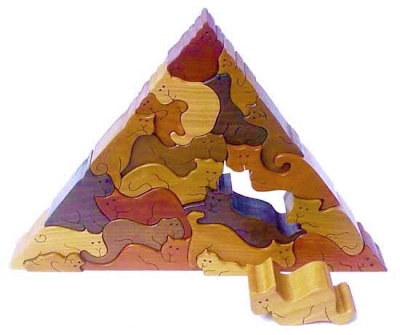 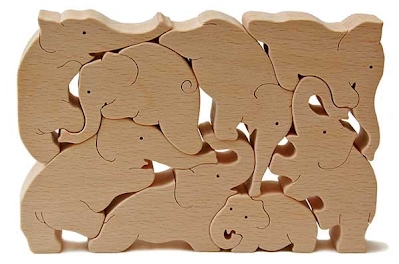  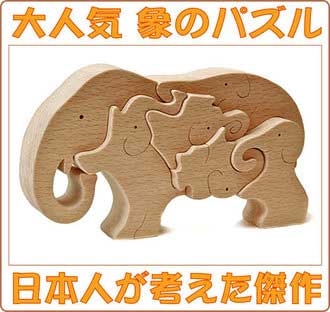 From left to right, top to bottom: 22 cats in a triangle; Elephants; 43 rabbits; Elephants as a puzzle within a puzzle 1984, John Wright Company/Barbara Stork Puzzle inventory, in chronological order, with dates and number of pieces: 1. Animals, 1984 The John Wright company, of Wrightsville, Pennsylvania, USA, in association with the artist Barbara Stork of The Greater New York City area, USA, produced a most unusual instance of the cluster puzzle premise with a series of cast iron bakeware molds, from 1984-2011 (the product is now discontinued, but is widely available on eBay and elsewhere). These vary in cluster premise, with strict adherence to tessellating principles, to considerable open spaces. Three examples of note can be seen: ‘Animal Puzzle’, ‘Sleigh O’Toys’ (a Christmas theme) and ‘LL Bean’ (eight teddy bears in a variety of poses). Note that there are a few others seemingly quite close, and arguably could be included here, but are omitted. 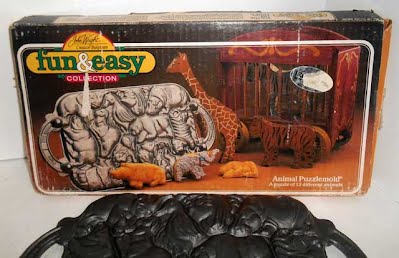 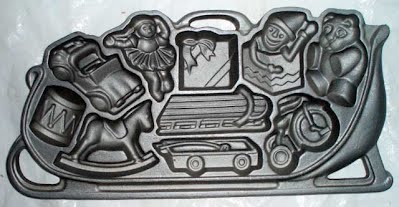 1985, AIMS Puzzle inventory, in chronological order, with dates and number of pieces: 1. c. 1986-1992, Pacific Puzzle Company/Sandra Ure Griffin Puzzle inventory, in alphabetical order (not chronological, which is unknown) and the number of pieces in brackets: 1. Birds of a Feather (44) 2. Creepers and Crawlers 1 (31) 3. Creepers and Crawlers 2 (34) 4. Earth Day* (7) 5. Eight Elephants (8) 6. Faces (25) 7. Five Rabbits (5) 8. Four Horses (4) 9. Nineteen Dinosaurs (19) 10. Seven Cats (7) 11. Six Dinosaurs (6) 12. Trucks (7) 13. Whales & Fishes (39) *Earth Day is included with reservation, in that it only has minimal cluster puzzle elements. As detailed in the explanatory text above, such themed instances possess ‘added value’ over a non-themed instance. Pacific Puzzle Company, of Anacortes, Washington, US, has produced 13 themed wood cluster-type puzzles, as above, from the mid-1980s to the mid-1990s. Aside from the cluster puzzles, they also marketed others, including a Dymaxion World puzzle, a wooden apple and a sandwich, of which here I do not discuss being beyond the scope of the page. In short, the puzzle can be described as a collaboration between the company, named after their location, and is of a small, two-person concern (rather than a national one) run by the brothers Lee and Ian Woofenden, and that of Sandra Ure Griffin, the artist. Pleasingly, unlike most entries here (with some entries research thwarted by the passage of time), the whole story can be told first hand, from information supplied by all the people above. A brief background. Griffin initiated contact with me (31 November 2019) upon seeing an initial, decidedly limited entry on this page as to the puzzle, when detail was essentially unknown, save for a brief reference on (as of 2020 defunct) puzzlehistory.com site added by Anne Williams, the jigsaw puzzle authority. Griffin then passed details as to my research on to Ian and then he additionally on to Lee. And all of which have been most enthusiastic and helpful in documenting and clarifying details. The company background (previously unknown in the puzzle community) is best detailed from two emails, from Lee and Ian (the latter of a clarifying nature), of which I quote below: Ian Woofenden email of 11 December 2019: PPC existed from the mid 1980s to the mid 1990s, and was a small business that supported my family for about a dozen years. It was started because my brother Lee had had an interest in making puzzles since he was a teen, and I was interested in doing something that would keep me at home with my kids. The business got modest traction in craft fair, gift show, and toy show world — the latter two via reps. We sold tens of thousands of map puzzles to catalogs like The Metropolitan Museum, The Nature Company, Eddie Bauer, and more. I got bored of the business and moved on to other things. I did briefly try to sell the business, but never found someone excited/brave/foolish enough to take on a fairly labor-intensive, variable business. I still have the designs, knowledge of processes, etc., as well as some materials and equipment, and would be happy to talk with any interested parties. Sandy’s gorgeous designs were a minor part of our overall production, but were well-liked. Lee Woofenden email of 17 January 2020: … PPC started out as a partnership between my brother Ian and me, and was thus originally a two-person company... The initial product line consisted mostly of puzzles that I had already been making on my own before the company started, including the People Puzzle, several map puzzles, and some interlocking picture puzzles. Later, Ian bought my share of the company from me, though I continued for some time longer to do work for the company independently as a puzzle cutter. The company continued for several more years after I ceased to do any work for it. Unfortunately, I am unable to give you any dates for when any of these transitions took place. Of course, the company also farmed out work to various other people over the years it was in existence. Unfortunately, the mists of time have caused exact dates and order of the individual puzzles to be forgotten, hence the lack of chronology beyond a broad date range of 1986-1992, as related by Griffin. She also told me that the puzzles were designed independently of previous knowledge of the cluster puzzle genre, i.e. it was an independent invention. Background of Sandra Griffin (an assembly taken from her Facebook ‘About’ page and blog ‘Author and Artist’ page) Sandra Griffin, was born in St. Louis, US. She moved to Kansas City in the 1970s, where she studied printmaking at the Kansas City Art Institute. She is an artist, illustrator and printmaker, creating works in scratchboard, woodcuts, and digital images, and is still active in this field, to the present day (2020), but no longer of cluster puzzles. She is also a writer and educator. Her work is in galleries in Missouri, Illinois, and Minnesota. She is a longtime member of the Society of Children's Book Writers and Illustrators (SCBWI) and have won numerous awards from that organization and others. Puzzle Analysis Each puzzle, save for ‘Faces’, can be seen to be ‘minimalist’ in terms of interior detail with the animal simply in silhouette. Further, each is coloured simply, colour stained, with each motif of one colour. As can be seen, the number of pieces for the puzzles varies, from a low of 4 to a high of 44. Broadly, two distinctions can be made as to the pieces, with low, of eight pieces and lower (7) and high, of 25 pieces or more (6). These are all, save again for ‘Face’ of the higher standard, whole-bodied motifs, and they are without gaps or overlaps. The various animals, in general, are quite good in their articulations, but not outstanding, but certainly better than most. If pressed to select a best, I would choose 19 Dinosaurs. The silhouettes here are easily recognisable as dinosaurs and on occasion, specific types are recognisable, such as T. rex and Pterosaur. Further, this possesses a relatively high number of pieces, 19, without a diminution of motif quality, as sometimes occurs with other artists. Of the puzzles, in general, it is always interesting to find which have flourished, or otherwise. The dinosaur puzzles were the most popular, selling moderately well, at least in the context of the (limited) craft market. This is understandable; dinosaurs as a motif are a popular seller in other fields too, and especially the child market, of which they have decided (and documented) fascination. Indeed, everywhere I go, once primed (a late 2019 interest, from dinosaur tessellation correspondence with Alec Dixon) I see dinosaurs, on clothes and toys, and more! The interest is simply ‘transferred’ here on to the puzzle. Acknowledgements (in chronological order as to research); Anne Williams, for kindly drawing this puzzle to my attention. Sandra Ure Griffin, for making contact upon seeing my request for further details on Pacific Puzzle Company on the page. Ian Woofenden, for Pacific Puzzle Company background, pictures of the puzzle, brochures, and general details arising from the puzzles. Lee Woofenden, for Pacific Puzzle Company background, and general details arising from the puzzles.
© Anne Williams. Logo Acknowledgement (in chronological order as to research); Anne Williams, for kindly drawing this puzzle to my attention. Sandra Ure Griffin, for making contact upon seeing my request for further details on the page. Ian Woofenden, for Pacific Puzzle Company background, and pictures of the puzzle, and brochures. Lee Woofenden, for general details arising from the puzzle. Entry 17 January 2020. Updated 6 February 2020 upon additional clarification from Ian Woofenden. A previous entry was of 21 March 2016, entirely removed on account of more details coming to light. The 17 January/6 February 2020 entry is thus effectively new, being wholly rewritten. 1986, Hugh Jones Puzzle inventory, in chronological order, with dates and number of pieces/motifs: Hugh Jones, of Florida, USA, has created a single instance of animals as a drawing, 11" x 14", posted on his Facebook page. Upon making contact with him as to the background, this is what he told me: 1988, Wayne P. Godinet Puzzle inventory, in chronological order, with dates and number of pieces: 1. Animals, 1988, ‘Bed And Mattress Formed By Animal Shaped Nesting Play Cushions’, United States Patent 4,719,656. 1988 1989 and 1992, Porter’s Puzzles Puzzle inventory, in chronological order, with dates and number of pieces: Mary Porter, of ‘Porter’s Puzzles’, of California(?), USA, has produced three themed cluster puzzles, in wood, 11” x 8½”, two of pigs, and one of Artic animals. However, much background detail remains unknown. This appears to be very much of a homespun affair, rather than a large company; certainly, I can find next to no detail. Although there is indeed a label on a box, the image I have is of too poor a resolution to be largely discerned. Can anyone add to what is given above? Does anyone know of Mary Porter herself (I have looked for her in vain). Or indeed, can add to the story in any way.   Pigs, Artic animals C. 1990-2000. Unnamed Animal Puzzle Essentially next to nothing is known as to this unnamed animal puzzle, with only a very rough approximation on the date and possible country of origin, and that’s it! The at first unassembled puzzle, without any box or packaging, was drawn to my attention by Carole Bersani, of Massachusetts, US, in relation to an email puzzle query. She told me: I purchased the puzzle probably about 20-30 years back - possibly in New Zealand... or California! I vaguely remember that it is supposed to overlap and form a new image, but after viewing your assortment of cluster puzzles I’m doubting my memory and wondering if perhaps the pieces fit together side by side... although I’m fairly certain that the images should overlap. At first, I was unaware of this puzzle, and so I posted on 'The Association for Games & Puzzles International' (AGPI) forum for comment. One correspondent, Conrad Armstrong, investigated and solved the problem, from which Carole then assembled the puzzle, below. Having then seen the solution, I then recalled a like instance in my files, but not as a puzzle, but rather as a print on a t-shirt (I have misplaced the image). As to the puzzle, this consists of seven animals (bear, bird, camel, ‘frilled lizard’, kangaroo, rabbit, and rhinoceros) on a series of translucent plastic disks. The disk's diameter is a litle over 4". The premise is to overlap the disks as a broad circle to form an inner animal, which turns out to be an elephant. To me at least, without any guidance, the puzzle is diabolically hard and strictly unfair! It's essentially a puzzle with a piece missing! Likely the packaging gave a clue as to the nature of the problem. This is now at least established as a likely commercial puzzle. Can anyone add to the story here? In particular, I would like to know the designer, date, and puzzle title. No detail is too small to mention. Disc assembly, and graphic where the individual animals are made clearer © Carole Bersani 1993+, Rob Reger, ‘Emily the Strange’ https://www.facebook.com/emilythestrangerous/ Rob Reger, an artist of San Francisco, California, USA, with his company ‘Cosmic Debris’, has created ‘Emily the Strange’, a young girl character who appears in a variety of cluster puzzle type artwork surrounded by a variety of fantasy creatures, titled ‘Zonsters’. The premise of Emily is a black cat loving thirteen-year-old girl who tells the world to ‘Get Lost’, ‘Be Yourself’ and ‘Do it Yourself’, followed by a series of adventures. Emily the Strange is the original teen brand with attitude. Emily has garnered considered widespread media interest worldwide, in a variety of ways: books (a four-book series by HarperCollins), comics (a New York Times best seller), apparel (celebrities including Julia Roberts, Britney Spears, and Björk have all worn the brand). Beginning in 1993, Emily the Strange was created and drawn as graphics for merchandise, and the stories and fine art grew out of that. 1994, Jim Fambrough Puzzle inventory, in chronological order, with dates and number of pieces: 2. Critterfits, 1994, 20 pieces
Assessment: Assessing these is not ideal, due to the limited pictures I have, of just one of each puzzle, and not of the greatest clarity, as above. Be that as it may, these still poses enough detail to permit a fair, although not wholly ideal, assessment. These differ in their respective types, but are both pleasingly themed: 1. ‘Corvettes’ (cars), of ten pieces, with occasional overlap, and gaps, and is described loosely Type B-. As such, they essentially lack articulations As such, I am ambivalent on these. Both have weaknesses thereof in terms of types, although these are at least both themed. As a broad statement, these are of a lower to mid-range quality. Although not without merit, being themed, with largely identifiable motifs, they essentially lack articulations to greater or lesser degrees. Certainly, they are not of the top range, indeed, far from it, but that said, there are far worst examples on this page. My thanks to Anne Williams for drawing this puzzle to my attention. © Anne Williams 1994, Paul Gibbs and Tony Prischl of Makoulpa Company Puzzle inventory, in chronological order, with dates and number of pieces: 1. Africa, 1994, 5 pieces 2 Africa, 1994, 34 pieces 3. USA, 1994, The company Makoulpa, with owner/designers Anthony Prischl and Paul Gibbs, goldsmiths and jewellers, have produced three cluster puzzles of a country outline theme, two of Africa (of different forms, detailed below) and later one of the USA. These all show indigenous animal motifs in relief form, in different constitutions, of gold, sterling silver, and more recently in pewter. Such a metal medium is rare; the only other instance I am aware of is by Angiolo Logi. These were in effect begun in 1984, or at least in idea form, and subsequently in a simplified manner, without detail, before a definitive, final form in 1995. Each piece is detachable, and can be worn as a pendant. All these are available as commercial items, and are presented in a sumptuous way, complete with presentation box, details as on the website link. Concerning the puzzles themselves, the two African puzzles differ in format and number of motifs and inherent quality of design: Small format, with just 5 animal motifs, of ‘heads’ Large format, of 34 animal motifs and shows the creatures ‘whole bodied’. The ‘small format’ instance is of lesser consequence, being of a lesser category of difficulty. The large format is by far the more impressive, with whole bodied creature, and with a considerable number, but all the while retaining inherent quality, which is not always seen with others of a comparable premise. The inherent quality of the motifs is most high indeed, with easily recognised motifs and with good articulations. Only minimal ‘wriggle room’ is needed on occasion. The USA instance is also of a large format with many whole-bodied motifs, and is likely equally impressive, although the exact number of motifs and quality is hard to discern from the photo, shown at a raking angle. Finally, of note is the country outline concept, which is not an isolated, unique offering. Such a concept can be seen in the work of others, namely George Luck (UK, New Zealand, Australia), Csilla Plathy (Australia), Angiolo Logi (Australia) and Adam Laurance (Australia). © Paul Gibbs and Tony Prischl 1994, Steve Shumaker and Annie Power of 'Pieceful Solutions' Puzzle inventory, in chronological order, with dates and number of pieces: 1. Fish, 1994, The background to this is obscure. I have not been able to find any details of Shumaker and Power. A mail to Shumaker went unanswered. Does anyone know of them? A fish instance is shown on a black and white plate in [8]. 1994, Designer unknown, Cat and Pigs (Not seen) Puzzle inventory, in chronological order, with dates and number of pieces: A 1997 patent by Denise M. Stevens refers to a journal/magazine? titled ‘Bits and Pieces’, December 1994 (and 1995), pp. 41 and 50, who advertised two puzzles called "Heeps [sic] of Cats" #05-K2717 and "Heeps [sic] of Pigs" #05-K2719. This is described as ‘…Although a couple pieces have their own significant shapes when apart, the remaining pieces are distorted-requiring the other pieces to be attached in order for the animals to look complete’. 1995, Michael Angulo Puzzle inventory, in chronological order, with dates and number of pieces: Michael Angulo, an American artist, has created three instances all comprised of animals, titled Synergy, Interdependent, and Complementary, of 1995, 1998 and 2001 respectively. These are all hand-drawn with coloured pencils, and are all approximately 18” x 24” in size. These slightly differ from the others here in that they fan out from a central point, with a ‘triple repetition’, i.e. with order three rotational symmetry; no other artist of the listing here presents their work like this. Also, the works are shown ‘as is’; although the impression is given of an artificial rectangular border, as one might expect the motifs to continue with the rotation theme, but this is not so.
1996, Debi McGary Puzzle inventory, in chronological order, with titles, dates and number of pieces if known: Debi McGary has produced six themed wood cluster-type puzzles: ‘Grandpa's Farm’, ‘Ocean Friends’, ‘Forest Friends’, ‘Dino & Friends’, ‘Children Of The World’, and ‘Noah's Ark’, shown in her book Wonderful Wood Puzzles. The premise is of an arts and craft/tole nature, with instructions on how to make these. However, although are indeed of a ‘cluster puzzle’ nature, there are indeed liberties taken with the premise, with much open spaces and faux articulations, far too much for the purist’s liking; nonetheless, the premise broadly remains, albeit with considerable reservation at times. Of course, she may not be approaching this as according to the stricter standards of tessellation, and so such comments are out of place, at least in an arts and craft sense. c. 1996, Stanford A. Graham Puzzle inventory, in chronological order, with titles, dates and number of pieces if known: The ‘Anything’s Puzzable’ company, apparently under the ownership/design of Stanford A. Graham, has brought out three themed and alike circle format cluster puzzles as jigsaws of animal motifs (widely available from Amazon), titled Our World’s Most Amazing Endangered Species, An Amazing World of Dinosaurs and An Amazing World Beneath the Sea. These are all of 1996, of a large 25¾” circular composition (also see Simplex puzzles for this format, although their respective puzzle are indeed distinct). At least two of these were patented (‘dinosaurs’ and ‘sea’, whilst ‘endangered species’ has not been found). See: Assessment: Type A, three instances, all are themed, of ‘endangered species’, ‘dinosaurs’ and ‘sea creatures’, and are of a relative high quality, with numerous pieces, 100, 75 and 69, with good articulations and quality artwork. There is much to praise here. My thanks to Anne Williams for providing the catalogues. An Amazing World of Dinosaurs and An Amazing World Beneath the Sea Catalogues © Anne Williams 1996, The Suitcase Puzzle, Designer Unknown Puzzle inventory, in chronological order, with dates and number of pieces: An unknown designer for the Bear, Bear, & Bear company, of England, in 1996, designed a single, themed commercial cluster puzzle in plastic, titled ‘The Suitcase Puzzle’, of which the premise is of a packing nature, with clothes, in which the c. 18 pieces pack into a suitcase in two layers. Of note is that this first and only instance of its type, and so an interesting novelty, aside from the usual animals. However, the clothes are of somewhat questionable worth, being little more than arbitrary shapes in the main. Background matters are sadly lacking; I am only familiar with two references, and the box has next to nothing. I cannot find The Bear, Bear, & Bear company as well as the designer. © Rob Stegmann 1997, Rene Soriano Rene Soriano (born c. 1930) of Beverly, Massachusetts, US, has a US patent 5,628,513 of May 13, 1997, titled ‘Puzzle/Play Set Toy Product’, of a Noah's Ark. Unlike other such puzzles, where the animals are placed within a broad ark outline, the ark is in the centre, surrounded by nine pairs of animals: ducks, elephants, giraffes, monkeys, penguins, pigs, lions, rabbits, sheep, and zebras. Noah is not shown. Of note is that the two by two theme is more overt than others, and is at least consistent throughout. This is apparently the only Noah's Ark cluster puzzle with a patent. Whether this was produced is not known; I have not seen it come to market. The puzzle is undoubtedly aimed at children, with simplified, cartoon-like animals. Like many others, it has a dual purpose, as a puzzle and a playset, where the pieces can be made to stand up or permit stacking (as the patent describes). The pieces vary in their veracity in silhouette, as well as being a little more contrived than I would like, for instance, the giraffes, having very short necks. Some are essentially unacceptable as to higher design standards, such as the two elephants being nothing more than elephant detail inside a broad, rectangular tile. Other animals lack articulations. Of interest is the presentation of a central ark and mostly surrounding animals within a broad, rectangular outline. Such a presentation is not seen in others. The premise seems a little strange, in that all the animals would not fit in the ark! Only the ducks are shown inside the ark. However, one could argue that this was intended symbolically. Although Soriano is not perhaps a household name to most people, he has indeed acquired a degree of fame as a game designer and inventor for Parker Brothers and a creative projects manager for Hasbro/Parker Brothers. Along with Eddy Goldfarb he invented such famous games as Kerplunk (1967) and Battling Tops (1968). He also devised the lesser known SKOOZ-IT Pick-A-Picture Game, of a jigsaw nature (1963). Patent1997, Denise M. Stevens Puzzle inventory, in chronological order, with titles, dates and number of pieces if known: 1. Nativity, 1997, 11 pieces United States Patent 5,615,883 This is obviously based on David Ashe's nativity scene in Better Homes and Gardens, as described above 1998, Susan Brack Puzzle inventory, in chronological order, with dates and number of pieces: 1. Here Kitty, Kitty, 1998, 100 pieces Susan Brack is a self-taught folk artist from the Midwest in the USA. ‘Here Kitty, Kitty’ was created as an exercise in primitive folk art. There are around 100 cat figures, built around the tabby cat centred in the middle of the design. The work measures 14 x 17 inches and was created in 1998. It is mixed media on illustration board and is a combination of watercolour, ink and coloured pencil.
Here Kitty Kitty © Susan Brack c. 2000, Csilla Platthy, of Mr Puzzle company, 16 pieces Puzzle inventory, in chronological order, with dates and number of pieces: 1. Australia, c. 2000, 18 pieces Csilla Platthy, of Sydney, Australia, has created an Australian theme cluster wooden puzzle, but with a twist in the tail. Various creatures of Australia are produced as in a ‘traditional’ cluster puzzle, but this has an additional aspect, in that these are contained within an Australian country outline. As might be imagined, this is of an order of extra degree of difficulty, albeit tempered by having relatively few pieces here, although each country poses its own problems. Such interwoven elements give a pleasing cohesion to the composition. This idea, of native animals within a country (or continent) outline can also be seen in the work of others: George Luck (UK, Africa, Australia, New Zealand, North America), Anthony Prischl and Paul Gibbs (Africa and US), Oswaldo Rosales (Venezuela, US), Angiolo and Ilaria Logi (Australia), and Adam Laurance (Australia). Australia certainly seems to be a popular theme! © Csilla Platthy 2001, Daryl G. Clerc and Pamela A. Clerc Puzzle inventory, in chronological order, with dates and number of pieces: 1. Animals, 2001, 'Figural Puzzle’. United States Patent 2001/0052670A1. 2001 Does anyone know of the Clercs? 2001, Ton Schotten? Puzzle inventory, in chronological order, with dates and number of pieces: 2002, Fat Punk Studio Puzzle inventory, in chronological order, with dates and number of pieces: 1. Fantasy creatures, 2002,
In style, this resembles very much Escher's own two Plane Filling instances, although this is indeed an original work. The work has many pleasing features that point to a quality production: Themed, all with animals (save for one human figure), albeit fanciful at times Numerous motifs, without a reduction in quality as commonly occurs More difficult to achieve whole-bodied motifs, with one exception, of a head Good articulations, with the motifs shown in a ‘typical’ pose Upright motifs, and so the composition appears ‘sensible’ Contrasting colour, so that each motif is readily discernible A ‘true’ tessellation, without any ‘wriggle room’ whatsoever, never mind gaps and overlaps that sometimes pass as ‘tessellation’ Of interest is the high degree of detail of the animals, with a precise and incredibly skilled computer rendering. Overall, I am most impressed with these, first of the computer technique, and second in the inherent quality of the motifs in the round, as detailed above. 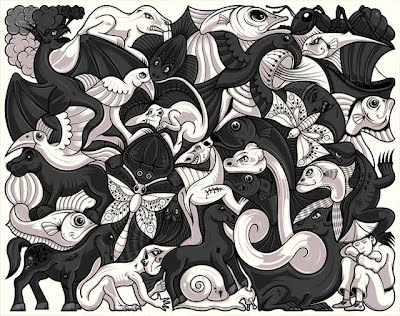 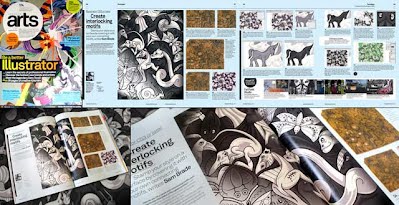 Plane Filling © Fat Punk Studio Montage of article in Computer Arts, 2010 © Fat Punk Studio c. 2003, Dave Janelle, Creative Craftshouse http://www.creativecrafthouse.com/index.php?main_page=index&cPath=135 Puzzle inventory, in chronological order, with dates and number of pieces: ‘Creative Craftshouse’, under the leadership of Dave Janelle, has a varied puzzle making business (in the ethos of a Jerry Slocum nature) in Florida, US. Under the sub title ‘Picture Frame Puzzles’, he brought out many wood puzzles (about 50 distinct) of a variety of themed objects of a cluster-like nature, albeit there are concerns here as to cluster intent. These are of a mostly square composition, 7” x 7”, of a ¼” thickness, from 8-22 pieces. However, most of these are simply representational objects loosely ‘pushed together’ to form a ‘packing puzzle’, and so thus diluting the tessellation principle of a double contour. Indeed, none of these is ideal. However, they are indeed a few broadly worthy of the description, although there is no hard and fast dividing line here. Consequently, the discussion here is somewhat subjective. Upon correspondence with the designer asking for more details, I learned that he was unfamiliar with the strict cluster puzzle concept, and so as he was not aiming for the concept, one should not be too critical here in treating these as ‘failed’ examples of the genre. Rather, they should be judged as according to their type (‘packing puzzles’), and of which there are many pleasing examples. For pictures of all 50+ puzzles see the above link. Assessment: As alluded to above, what to include here is fraught with difficulty. What should I include? All, or a subjective choice? There are pros and cons here. However, I have chosen to be selective, and have chosen what I have considered to be cluster puzzle in intent, and disregard he rest. Those puzzles most in intent are ‘Sea Creatures’ and ‘Cats and Dogs’ (both of eight pieces). However, both remain questionable, both of Type C (lowest category). Both puzzles are themed; of animals, of a like quality in style. Each puzzle consists of a relatively low number of pieces and of which these are thus not always fully surrounded at their outlines and so pale in comparison, noticeably so, with other more numerous examples of more exacting double contour standards. Indeed, one could almost say this is a broad minimal number to remain cluster puzzle in intent. The pieces are with easily recognizable animals. Overall, with reservations as to type, two relatively pleasing puzzles, albeit qualified by the significant lack of number of the motifs, which is a major shortcoming. c. 2003, Jerry Krider Jerry Krider, of Indiana, US, can be described as a puzzle woodcarver, although much detail of him remains unknown, whether by accident or design. Although he does indeed have a web presence, along with other artists, on ‘Creations Gallery’, of Delaware, who describe themselves as a ‘unique American-made, hand-crafted gifts, furnishings and accessories in wood, glass, metal and ceramics for home and office. He gives a basic (and brief) artist’s statement here. He doesn't have a website of his own. ‘Creations Gallery’ was once bricks and mortar, but has now closed down (since 2018). It now only operates online, and which acts as the prime outlet for his work. A far more in-depth account of him is given in a local Indiana newspaper, The Journal Gazette. I quote both of these in full below. He is (so far as I can tell) inactive on social media, appearing only passively, and even then, barely so. A (2016) email to him went unanswered. Johah's JourneyFrom Creations Gallery: From the rural plains of Indiana, Jerry Krider of Claywood Creations creates intricate puzzle-like sculptures. Religious themes highlight a large portion of his work, including nativity wall hangings and Christmas ornaments. His work also includes whimsical pieces featuring human figures, cats, dogs, and hearts. Jerry attended the Herron School of Art and has Bachelor and Master's degrees in science from Ball State University. The Journal Gazette: Krider made his first Nativity scene out of a piece of cedar from a tree that his sister had cut down at her home. He made four Nativity sets for her children. After that, he began to use wood leftover from his work making bassoons at Fox Products in South Whitley. The company used a lot of exotic wood, an element that he continues to use in his scenes. Krider makes about 50 types of Nativity scenes, all from exotic woods but with different patterns. Some are 3-D pieces, while others are puzzles. Krider uses such woods as red heart from Mexico, maple and walnut. He likes to go to the stores to see the wood so he knows he is getting good quality and the colors he needs for his designs. For autumn pieces, he will use six colors of wood; for winter, he uses a whitewood to show snow on branches. Growing up in Columbia City, where he still lives, Krider says his family went to church and that making Nativity scenes “was a logical extension of my faith and my interest in art.” Krider has been selling his art full time since 1997. Most can be found at art shows or in area galleries, such as the Orchard Gallery on Covington Road. He says he had an interest working with wood while in high school. He went to art school and graduated from Ball State in 1966. And while he learned the principles of design and working with 3-D designs in school, the Nativity scenes and woodworking are something he developed on his own, Krider says. Nativity scenes, however, are not the only thing Krider makes. He also makes puzzles in other shapes, such as cats or dogs. Krider doesn't have a website, but he says people can Google his name and find out what galleries have his artwork. This does at least serve for basic background details. However, much of him and his puzzles remain unknown. His age (not that it is important) and dates of the puzzles are essentially not known. Indeed, it is only by examining a single Nativity puzzle found on WorthPoint was I able to put at least a rough guide, inscribed with a 2003 dating. From the above, likely his cluster puzzles are a device of his own invention, and he is unaware of the genre as such. Assessment: Type B-C (mid-range to lower category). A pleasing aspect is that of various themes, eight, and so he intuitively understands the superior nature of this premise. However, the silhouettes and articulations are lacking in intrinsic quality, with varying degrees of gaps. The number of pieces for any one puzzle is decidedly low, of just 5-7, and 12 pieces (with one outlier of 23? pieces), and so generally these lack a (desirous) double contour throughout. My main concern though is the considerable vacant spaces at times, with in particular ‘Hues of Humanity’. However, he does design according to higher principles, such as ‘Jonah’s Journey’. However, as a rule, he favours a looser interpretation of the premise. However, this should not be taken as a criticism as such, but rather as an observation, as likely he is not designing according to the higher standards, as to none or minimal gaps. Picking a best is an invidious task; there is no single standout work. However, if pressed, with reservations as detailed above, I do like ‘Jonah's Journey’, if for only largely adhering to the stricter standards of the cluster puzzle premise.
Links Creations Gallery - Jerry Krider’s dedicated page https://www.creationsgallery.com/wood?tag=Jerry%20Krider The Journal Gazette. ‘Holiday for creativity’. Sunday, November 26, 2017 https://journalgazette.net/entertainment/20171126/holiday-for-creativity Princeton University https://www.facebook.com/princetonuniversityartmuseum/posts/10154786990741079 Nativity puzzle with date https://www.worthpoint.com/worthopedia/framed-puzzle-nativity-scene-set-1965701011 New entry 17 July 2020 (although I have known of Krider's work since 2016) 2005, Ulrike Gattermeyer-Kapp and Manfred Kapp Very little is known as to this puzzle, beyond core matters as to the designer and date. All that is known is taken from the database of ‘Ludorium’, an online Austrian Games Museum. Ludorium states that this is by Ulrike Gattermeyer-Kapp and Manfred Kapp, and is of 2005. The Kapps can be described as board game designers. There is no other detail of relevance. The puzzle measures 34.2 x 23.2 x 4.8 cm, of 18 pieces. The puzzle is marketed by Selecta, of Germany, who have been developing high-quality, hand-made wooden toys for over 50 years. The puzzle bears some resemblance in style to that of Enzo Mari, perhaps with the intent of emulating him, but is indeed original. Box text: Tierpuzzle Ein echtes Designstück: handgearbeitwtes Tier puzzle aus eichenholz. Der Blickifang zum puzzeln, Tasten und Entdecken … natürlich aus holz Translated: Animal puzzle A real piece of design: handcrafted animal puzzle made of oak. The eye catcher for puzzling, touching and discovering ... made of wood, of course (Revised entry of 26 February 2021, following information kindly supplied by Lucienne Verhaar) c. 2005+, Bobby Bogl 1. Tessepuzzlation Bobby Bogl shows eight instances on his webpage, three of which are shown below Interlocking Everything, Unbound, Canines. These are loosely themed, and consist of a collection of animate and inanimate motifs. The motifs are all in an upright orientation, of an exceedingly high number. All four instances are very much alike in style, and are nicely rendered, to a realistic degree. Although there are a few ‘amputations’, these are few and far between, and indeed, one has to search very hard to find any serious distortions here, which is credit to the artist (contrast this with others). Of note is how generally ‘strong’ these are in silhouette and not just formless shapes with interior decoration much beloved by other inferior tessellation artists. Although there is the odd example of the lower degree of difficulty of ‘heads’ here, this is almost inevitable, and should not be looked upon as an inherent weakness. All in all, some pleasing compositions indeed.
1. Interlocking Everything, 2. Interlocking Animals, 3. Interlocking Canines c. 2006, 2015, Michèle Wilson Company, Designer François Tard Puzzle inventory, in chronological order, with dates and number of pieces: 1. Animaux Familiers en Folie, 12 pieces 2. Animaux en Folie, 24 pieces 3. Dinos en Folie, 24 pieces
The Michèle Wilson Company, of France, with a showroom in Paris, has been cutting wooden jigsaw puzzles since 1975, and has established a notable concern of 300 puzzles, of which in 1997 the business has been taken over by Sophie Ollé-Laprune and Julien Vahanian. Among their extensive range are three themed cluster puzzles, designed by François Tard (with the number of pieces in brackets), Dinosaur Puzzle © Michèle Wilson Company c. 2007+, Plexus Puzzles http://plexuspuzzles.com/ Puzzle inventory, in chronological order, with dates and number of pieces: 1. First, to whom the Plexus series of puzzles should be credited to is not at all clear. I have received no response to two perfectly reasonable requests for permission to use images and background details a year apart (and I know of another correspondent who has suffered a similar fate, so it’s just not me). Somewhat oddly, they seem to delight in obfuscations. There is not a single named person stated on their website! The puzzles appear to have been devised by the company ‘Plexus’, based in the US, ostensibly under the leadership of one ‘Ryan J.’ (no surname given), of which for now at least I thus credit. Furthermore, to what extent the artwork is of their own is unclear. At least once (cotostudio.com) they have contracted the design out. Possibly, Plexus have an initial idea, and then contract the work out; the finished artwork shows different styles. Even seeing the images is not straightforward! The website itself is not helpful, with which generally only portions of a whole puzzle are seen! They seem to be scared of showing the whole, for unclear reasons, with the whole puzzles only available for purchase as a download on the Apple App Store as an online game. The best means of seeing their images is a Google image search on ‘Plexus puzzles’. This seems to one of those (few) artistic websites that are strictly ‘business matters only’, and ‘don’t bother us on anything else’. Strictly, on account of all this they are undeserving of my time, but such matters are their own business, and so nonetheless I assess their instances in line with the others here for the sake of consistency. However, with so much underlying uncertainty, the following should be taken as a rough guide. c. 2008, Jack Zylkin Puzzle inventory, in chronological order, with dates and number of pieces: 1. Sea creatures 2. Zoo 3. Bugs 4. Pets Jack Zylkin, of the US, has compiled a series of four themed cluster puzzle instances. These were originally designed as a ‘long strip’ to wrap around a lampshade when joined at the ‘short edge’. However, although strictly this thus means that the motifs repeat lengthways, and so loose the ‘openness’ of a true cluster puzzle, this is essentially a minor quibble; the motifs could have been designed without this aspect, and as the intention is overwhelmingly of a cluster puzzle, it is thus included in this collection. The motifs are rendered in a simple manner, with a single colour for each motif, of a relatively small number of motifs. c. 2008 Artsoftheheart ebay ID Puzzle inventory, in chronological order, with dates and number of pieces: 1. My thanks to Anne Williams for drawing this puzzle to my attention. 2009, Oswaldo Rosales Puzzle inventory, in chronological order, with dates and number of pieces: 1. Venezuela, 2009, 34 pieces 2. USA, 74 pieces Oswaldo Rosales has created two cluster puzzles, of a country theme, namely of Venezuela (his home country) and the US. ‘Venezuelanimals’, created in 2009, is of 34 pieces, and represents different species of animals on air, land and water, and took two years to design. ‘USAaminalpuzzle’ of 74 pieces, depicts animal species of the USA fauna, and is a big laser cut puzzle of 21" x 17" x 1/4". The inspiration for these came from seeing, when he was a child, the work of the Italian designer Enzo Mari, namely of the ‘16 animals’ puzzle. © Oswaldo Rosales 2010, Tozzwords, a puzzle company Puzzle inventory, in chronological order, with dates and number of pieces: 1. The ‘Tozzwoods’ company, of Singapore, has produced within a wooden puzzle category aimed at children a variety of cluster-type puzzles, all of an animal premise. However, who the designer is and year of making uncertain. The company at least appears to be of 2010. 2010, Juan Pablo Quintero Puzzle inventory, in chronological order, with dates and number of pieces: 1. Elephants, 2010, 2 pieces 2. Doves, 2010, 2 pieces 3. Horses, 2010, 2 pieces 4. Foxes, 2010, 2 pieces 5. Snakes, 2010, 2 pieces 6. Fish, 2010, 2 pieces 7. Rabbits, 2010, 2 pieces 8. Monkeys, 2010, 2 pieces ‘Zoomaderita’ puzzles, designed by Juan Pablo Quintero and manufactured in wood by his Mediodesign company, come in eight different animals to complete an original zoo: elephants, doves, horses, foxes, snakes, fish, rabbits and monkeys. These are of a minimalist nature, with each puzzle of just two pieces. Arguably, such types are too simplistic in style for inclusion here, but I have decided to include nonetheless. © Juan Pablo Quintero 2010, Johan Olin and Aamu Song Puzzle inventory, in chronological order, with dates and number of pieces: Johan Olin and Aamu Song, from Helsinki, Finland with their design practice COMPANY, designed in 2010 a single cluster puzzle titled ‘Animals of Finland Puzzle’, of a country outline theme (such a country theme can be seen in others) with indigenous animals, not unsurprisingly of an obvious connection. The puzzle shows 15 indigenous animal motifs, of a fox, owl, weasel, wolverine, grouse, wolf, lamprey, bear, ringed seal, moose, marten, salmon, squirrel, rabbit, and swan. This is of birch veneer wood, and of which the ‘standard size’ puzzle measures 270 x 150 x 19mm, although there is a larger version. This was largely an independent idea, although of note is that the designers were familiar with Enzo Mari’s work in this field. © Johan Olin 2010, 2013, MC Felix
Puzzle
inventory, in chronological order, with dates where known: 2. Ibizan Hound, 2010 3. Pharaoh Hound, 2013 4. Smooth Haired Dachshund, 2013 5. Long Haired Dachshund, 2013 6. Saluki, 2013 7. Afghan Hound 8. Basenji 9. Rhodesian Ridgeback 10. Whippet
MC Felix, from Valthermond, The Netherlands, has compiled a most interesting series of themed puzzles, as line drawings, namely of dogs, with a further distinction of a specific breed for any one drawing. Such specifics are a most pleasing feature, in contrast to puzzles with generic dogs (although this is not to denigrate such instances; it just that these are of extra merit with the distinction). Indeed, no other artist has attempted such instances, and furthermore, there are not just of one or two shown or could be hoped for, but rather of no less than nine instances. Further, these are not just a few in number, but ‘of many’, typically thirty or so dogs of each drawing. On occasion, there are more gaps and overlaps than I would like, as well as use is made of heads only, but they are to a relatively minor extent, and so they remain more than acceptable as cluster puzzles. Some instances are less readily defined than others, seemingly due to the detail of the artwork. In general, preferred is a clearly defined motif, although it must be borne in mind that the artist is not likely to be drawing these with this aspect necessarily to mind. Of the oeuvre, in particular, I like the Smooth Haired Dachshund and Whippet, although picking a clear favour is not possible, others are of a like standard to those shown; with the Rhodesian Ridgeback and Saluki of essentially near equal or of even merit. Furthermore, the artist also tells me more of these drawings are coming up, with many breeds left to draw. And also, there will be jigsaws made of these in near future, although these are still in the development stage. 2011, Designer unknown Puzzle inventory, in chronological order, with dates and number of pieces: 1. Mushrooms 2012, Juan Calle Puzzle inventory, in chronological order, with dates and number of pieces: 1. Animals, 2012 By ‘Onikaizer’, on Deviant Art. This was a discarded design for an activity book for children, ‘Papermania’. 2012, Yana Skaler Puzzle inventory, in chronological order, with dates and number of pieces: ‘Nesting Animal Puzzle’ Of note (following correspondence) is that this is not a independent composing (as is usually the case), but was inspired upon seeing an ‘16 Animali’ Enzo Mari puzzle. For those interested in owning this, it was designed as a ‘Ponoko’ (an on-line design and manufacturing company) give-away file; see above link (scroll to bottom  © Yana Skaler 2013, Ray Delgadillo Puzzle inventory, in chronological order, with dates and number of pieces: Ray Delgadillo, a US designer, has created, in 2013, a single, animal-themed wooden cluster puzzle titled ‘The Oak & Its Family’ of seven pieces. This is of a didactic nature that teaches children about the different animals that coexist in an oak tree; the interlocking pieces create a visual metaphor for the coexistence. The pieces are based on data from the National Wildlife Federation and are made from (what else!) white oak lumber. The idea for the puzzle was influenced by seeing the work of Italian designer Enzo Mari (such an influence can be seen elsewhere). All in all, a pleasing, cohesive puzzle on various counts. © Ray Delgadillo 2014, Studio DUNN Aminal (sic) puzzle Puzzle inventory, in chronological order, with dates and number of pieces: 1. Animals © Studio DUNN 2014, Francesc Crous and Alessandro Calogero Puzzle inventory, in chronological order, with dates and number of pieces: Francesc Crous and Alessandro Calogero, from Barcelona, Spain with their design studio CrousCalogero designed in 2014 a single cluster puzzle of 15 animals, of a commercial nature, of a cookie cutter of a circle format, made by the Italian company Lékué. The work was loosely inspired by both Enzo Mari and Escher’s tessellations. Such an application is a first, although there is a similar idea, of molds, by the John Wright company (see 1984). © Alessandro Calogero 2014, Hayley Ho and Thomas Guest http://play.hayleyho.com Puzzle inventory, in chronological order, with dates and number of pieces: Hayley Ho (UK and Hong Kong), a graduate of Central Saint Martin’s art college in the UK, having studied product design and Thomas Guest (UK), a graduate of Nottingham Trent University having also studied product design and now a furniture designer, have produced a single themed wooden circle 204mm diameter, 30mm depth format cluster puzzle for children. © Hayley Ho and Thomas Guest 2014, 'RSPCA Assured’ Logo, by Harrison Agency http://harrison-agency.com/work/rspca-assured/
A relatively minor occurrence is the ‘RSPCA Assured’ circular animal logo, by Harrison Agency, of Brighton, UK. Although this is perhaps not strictly in keeping with most of the examples on this page, it consisting of just three animals (chicken, pig and a fish), and further has a weak premise of double contour, and so could arguably thus be excluded. However, despite the above concerns, it is nonetheless still of cluster puzzle principles, and so I have decided to include due to its prominence, it appearing on a whole range of farm and food products in supermarkets, nationwide, across the UK. The logo, to help with a name change, formerly ‘Freedom Food’, and was rebranded to meet animal welfare standards set by the RSPCA, was a joint collaboration, designed by Chris Harrison, the creative director, and Scott Welti, graphic designer and illustrator. The logo is of 2014 but was not put into the public domain until 2015. The design brief from the RSPCA stipulated that the new brand needed to include three or more animals, and Harrison worked on many routes before coming up with the final design. A circular device is explained as it is easier to place on the pack and it’s distinctive and elegant.
2015, Mirim Seo http://www.mirimseo.com/works/964 Puzzle inventory, in chronological order, with dates and number of pieces: 2. Ocean, 2015, 6 pieces 3. Arctic, 2015, 6 pieces 4. Jungle, 2015, 6 pieces 5. Desert, 2015, 6 pieces Mirim Seo, a graphic designer/illustrator from Philadelphia, USA (originally from South Korea), with a keen interest in animals and animal welfare, has produced five maple wood cluster-type puzzles in 2015, mostly of an animal theme, suitable, or aimed at, young children under the title of ‘Chomp’. 2015, Denitsa Krapova Puzzle inventory, in chronological order, with dates and number of pieces: Denitsa Krapova, a woodworker from Plovdiv, Bulgaria of Piron Woodworks, an Etsy concern, has produced four loosely themed wood cluster-type puzzles, of animals, fish (2) and ghost, suitable, or aimed at, young children. These are of a rather simple nature, with relatively few pieces; indeed, any one motif is not always surrounded by another, and so are thus of an easier degree of difficulty to achieve. © Denitsa Krapova 2016, Portland Puzzle Co. Puzzle
inventory and number of pieces: Each animal puzzle piece is hand made from real wood and painted with fun / bright non-toxic water-based paint…. The 3D animal kingdom puzzle is the perfect wooden puzzle for kids and toddlers. All pieces can be used as individual play pieces or used to assemble a puzzle…. Each piece is chunky and easy to hold for toddlers and young kids. Includes a total of 11 unique animal puzzle pieces including a hippo, rhino, elephant, fox, giraffe, alligator, koala bear, lion, hedge-hog, toucan & polar bear. and Trains, Planes & Automobiles theme…. Fun & Interactive - A great way for kids to learn about transportation & machinery….17 Unique wooden pieces that toddlers can easily grab for general play and puzzle completion…. Gender Neutral - Perfect for boys and girls aged 2-12 years old. Chunky puzzle pieces are ideal for play mats or pretend towns / cities However,
much background detail of these remains unknown (there is nothing of the
company history on the above sites. but were seemingly formed as of 2016), and
indeed, there is much uncertainty all round. A named designer is not given;
whether this was designed in-house, or contracted out to an unnamed artist is
not clear. Therefore, with so much uncertainty, this entry is subject to
considerable revision for a whole host of reasons as above.
Does anyone know more on this company and the people behind it? A mail to them
went unanswered. Or indeed, can add to the story in any way. My thanks to Anne Williams for drawing this puzzle to my attention. c. 2016, Art For Kids http://www.artforkids.fr/696282.htm Puzzle inventory, in chronological order, with dates and number of pieces: ‘Art for Kids’, a French fabric collective company, has produced a single loosely themed cluster-type puzzle, of animals, of a rug/carpet, suitable, or aimed at, young children. As such, by its very nature, this is of a design rather than a puzzle. The company is primarily focussed on fabrics, with a variety of applications, such as carpets, cushions, textiles, storage units, only one of which is of a cluster puzzle nature. The product is marketed outside of France, such as in the UK in a like range of stores (and likely others too), for £174, and is available in two sizes, 120” x 140” and 160” x 190”. The design featured in the Le Parisien newspaper, but the date was not discernable. Much background detail remains unknown of the Art for Kids instance, despite a good web presence and Facebook postings (a mail to them went unanswered). The date of creation is unclear, but the puzzle is presumed of c. 2016, from a posting on their Facebook page. The designer’s name is not stated; whether this is an in-house design or otherwise not clear. The company advertises for designers to send in their work, and so this is possibly the latter. Background matters aside, these are of a rather simple nature, with relatively few pieces, sixteen, or here, motifs. Indeed, the motifs are in general somewhat contrived, and occasionally truncated, albeit still largely recognisable, albeit by far off the higher standards. Save for the elephant, not a single animal is wholly surrounded, and so the principal of a double contour throughout is seriously weakened here. However, likely it was not designed with ‘high art’ in mind. Can anyone add to what is given above? In particular, I would like to know of the designer’s name. 2020, Demian Pedroza, ‘ZooSmart Cluster Puzzle’ Demian Pedroza, of Washington DC, US, has created a zoo-themed cluster puzzle, of hard tempered wood board, titled ‘ZooSmart Cluster Puzzle’. This is or is going to be, a commercial enterprise, with the prototype as shown in the video. Further animal instances are planned. However, this is still very much in the development stage, of which he is looking for investors. Entry 16 January 2020 Non-Dated Examples ‘3 Toys’ Puzzle inventory, of title and number of pieces: ‘3 Toys’ (or 3T Toys, the title is not exactly clear), have seemingly produced a single wood puzzle, of just seven pieces within a square format, loosely described, or seemingly intended, of animals, albeit most defy recognition, with only one likely identified with any degree of certainty, of a whale. Background detail remains unknown of this instance, and indeed of the company itself, and the year of manufacture. Despite an accompanying logo, of a clown behind a capital T, and bearing the ‘3 Toys’ designator and so thus giving the impression of a commercial company, I was unable to find them.
Background matters aside, these are of a rather simple nature, with
relatively few pieces, and all are with ‘forced’ articulations. As alluded to
above, with only one animal recognisable, the puzzle lacks merit. However,
likely it was not designed with ‘high art’ in mind and was perhaps marketed for
children, and so one can perhaps accept a little leeway here in this regard.
Can anyone add to what is given above? In particular, I would like to know of
the company, year and the designer’s name. Fred Szatkowski Puzzle inventory, in chronological order, with dates and number of pieces: 1. ‘USA’, date unknown of 44 pieces Fred Szatkowski, an artist of Depew, New York, USA, has produced a single themed 3D cluster puzzle, consisting of 44 indigenous regional animals of the USA in outline, cast of poly-resin with pewter finish, housed in velveteen within a black wooden case, of 8½" x 11½", with a see-through Plexiglas cover. However, much background detail of the puzzle remains unknown; although Szatkowski has a web presence, with a biography and contact details, he did not return my mail upon asking for further detail. This appears to be the only instance of the genre he did; his artwork is mostly of animals and nature in the conventional sense, many of which were turned into commercially available jigsaw puzzles. Benho Puzzle inventory, in chronological order, with dates and number of pieces: 1. Animals, 14 pieces Nothing is known as to the background of the ‘Benho’ instance. From the box alone, it is of Chinese origin, but as to designer and date, nothing. Likely, it is a modern-day product. A. K. Dewdney Puzzle inventory, in chronological order, with dates and number of pieces: Dewdney shows a single instance on his webpage, Cats. As might be imagined by the title, these are themed, with 37 motifs. The cats appear in a variety of orientations, of a high number, especially so for such a specific motif, with less leeway than an arbitrary selection of animate and inanimate motifs. The overall quality is good. This is easily seen as high quality, as the cats adopt a series of typical different poses, with the silhouette largely easily recognisable, and so these are not merely cat decoration features added to a formless shape. As can be seen, without the restriction of a duality of line at the edges of the composition, this enables the cats to be even more lifelike here, and as such is noticeably ‘looser’ at the extremities than with Escher's model. All in all, a pleasing composition. Yumeya Puzzle inventory, with dimensions and number of pieces: Yumeya, of Japan, has produced three confirmed themed commercial cluster puzzles, in wood, (there my be others, of other themes) of animals of continents and countries, namely of North America, Africa and Australia. These are packaged in a box, under the title ‘Yumeya, Crafts & Toy Collection’. Yumeya also possibly produced at least one other puzzle, of a non-continent theme, of a ‘Magritte Man’, tentatively dated 1977. As an aside, ‘Yumeya’ (夢屋) translates into ‘dream seller’. Non-Titled ‘Animal Puzzle’
Unfortunately, much of this single, themed, commercialised painted Beech wood animal puzzle remains uncertain and obscure. The designer is not known, nor the country of origin, nor the date. (And just to add further confusion, note that there seems to be another, smaller, puzzle of the same obscure type, with 9 animals, although this can be seen to be based upon the work of Dan Ngugen, of ‘Animal Stackers’, with Kickstarter funding. However, this has been described as a fraud, with Ngugen disappearing with the money without sending out the puzzle! Whether he has resurfaced here, or someone else is using his design I lack the will to delve further, and of which I will now continue the discussion with the puzzle above.) However, I suspect a modern day occurrence, of 2016, from accompanying marketing text. As such, this is heavily marketed on AliExpress, a major Chinese concern (echoing Amazon in extent), and so likely it originates from there, although details per se are scanty indeed. The puzzle measures 8½” x 8½” x ¾” and the premise appears to be a puzzle for a baby or child, and is described as such of the former, with ‘Baby Toy’. The number of pieces is relatively small, 13, but given the intended market is wholly understandable. As such, this is one of the more unusual cluster puzzles, in that rather than true life-like animals, with rounded contours of most instances, the animals are heavily stylised, likely purposefully so, with straight lines of a polyomino nature, albeit the motifs are still largely recognisable. The animals include: giraffe, zebra, elephant, snail, bird, dinosaur, camel, bear, hippopotamus, crocodile, duck, polar bear, fish, although the fish is unidentifiable. As with many others, there appears to be a dual purpose, with the pieces as playthings in their own right, as they can be made to stand up individually. Does anyone know more background details on this? Cluster Puzzle Patents in Chronological Order The following is a listing, of what can be described as cluster puzzle patents, in chronological order, despite these bearing at times, non descriptive title, or of a generic nature, such as ‘jigsaws’ or ‘puzzles’, ‘toys’ or other such non obvious terms. The order for each entry is as follows: designer, patent title, patent number (US unless stated otherwise) and date, followed by underneath some commentary text. Of note here is the successive awarding of patents, of which I thought that for a patent this was of a new nature each time, or it was refused. 1923 1931 1934 1944 1946 1959 1973 1988 1997 Denise M. Stevens*. ‘Figurine Puzzle with Display Apparatus’. 5,615,883, April 1, 1997 1998 2001 2009 Acknowledgements Geert Bekkering, for history and details of J. H. Schoonderbeek, W. Hahn, and Simplex puzzles Susan Brack, for drawing my attention to the John Wright bakeware molds Kelvin Palmer, for much helpful discussion concerning the history of his father’s puzzles, and numerous photo requests Anne D. Williams, for much guidance in a generalised way, and in particular for background details as to: Margaret Richardson; Pieceful Solutions, and for bringing to my attention puzzles by: Art Nugent; Jim Fambrough; Rochester Folk Art Guild; Stacey Roberts; C. Todd of Jigtime; Pacific Company Puzzle; Anything's Puzzable details, with a catalogue and ‘Endangered Species’ puzzle, together with various background details thereof and details of Donald Grundy, Portland Puzzles Bob Armstrong, for details of the Margaret Richardson ‘A Bad Dream’ puzzle Primitivo Familiar, for details of the 'Hasbro Romper Room Puzzle & Play Animal' puzzle Judy Gehman, for details of Margaret Richardson Melinda Shebell, for drawing my attention to a cluster puzzle forerunner, by Yoshifuji Utagawa Michael Hunter, for background details of the Rochester Folk Art Guild puzzle Mary of 'Tipple and Snack', for background details of the Art Orignals/Yumeda puzzle Dave Janelle, for background details as to his company, Creative Craftshouse Götz-Peter Reichelt, for background details as to his wood carved puzzles, and for drawing my attention to two Dorin Layeled Ltd. puzzles Heather Coyle, for details of John Sloan, and in particular his 'Blackbird' puzzle Yoshiaki Araki, for details of Japanese puzzles Laura Kutney, for details of George J. Paulus puzzles Ryan Martin, of the John Wright Company, USA, for telling me the name of the animal bakeware designer, Barbara Stork Lorenzo Logi and Angiolo Logi, for background details as to Australia Puzzle, and others, and for sharing their archives, and much assistance in a generalised way Hayley Ho, for background deteils as to the Orochen family forest puzzles George Escher, for his commentary as to his father's knowledge of Simplex puzzles Becky Raynor, for kindly forwarding my query to George Escher Lucienne Verhaar, for background detail as to the Selecta puzzle Carole B, for detail on a 'unnamed animal puzzle' of hers References: [*] Armstrong, Bob. Website: http://www.oldpuzzles.com/ [*] Burns, Tony and Joy Burns. [*] Escher, M. C. The Graphic Work of M. C. Escher. Oldbourne, London 1970. [*] Ford, Karin (translator). Escher on Escher Exploring the Infinite. Harry N. Abrams, Inc. 1989. [*] Fox, Linda (Editor), Daniele Ravenna (text) Mario Tedeschi: Australia Puzzle Contemporary Silverware & Jewellery 1994 (Re Angiolo Logi). [*] Hower, Carolea. Making Wooden Puzzle Playsets. 10 Patterns to Carve, Scroll & Woodburn. Fox Chapel Publishing 2015. [*] Palmer, Kelvin (1). The Collector’s Guide to Cluster Puzzles of the 1960s and 1970s. 2003. [*] Palmer, Kelvin (2). Website: www.azplerp.com [*] Schattschneider, Doris. Visions of Symmetry. Notebooks, Periodic Drawings, and Related Work of M. C. Escher. New York. W. H. Freeman and Company 1990. Revised edition 2004. [*] Williams, Anne D. The Jigsaw Puzzle: Piecing Together a History. Berkley Books, New York 2004. [*] Wikipedia - Art Nugent: https://en.wikipedia.org/wiki/Art_Nugent Created 22 November 2013. Previously, a small part of this essay, featuring the works of Bobby Bogl and A. K. Dewdney, was placed under another title, of 'Free Plane Filling'. 1 2014 27 March. Michael Angulo and George Luck puzzles added 22 May. Bobby Bogl Interlocking Animals and Interlocking Canines added 2 June. Susan Brack's Here Kitty Kitty and Lakeside's 19 Animals added 10 June. Sabu Oguro, Mark D. Dodd images added June. John Wright Bakeware added 26 June. Fat Punk Studio added 9 July. Patent pictures of Clerc, Godinet Graham, and Stevens added 14 June. 'Tozzwoods' added 23 July. Introductory test rewritten and greatly expanded Jack Zylkin added 9 September. Shigeru Kobayashi text and pictures added 2015 20 May. Anthony Prischl and Paul Gibbs and Angiolo Logi sections added 18 June. Rearragement and revision of material for a better read/presentation 1 July. Angiolo Logi text added 8 July. Mark D. Dodd text added 13 October. Romper Room Puzzle & Play Animals, Ducks in Formation, and Emily the Strange all added 6 November. 'Onikaizer' added 19 November 'Zoomerderita' added 7 December. 'University Craftsman' added 31 December. Arthur W. Nugent entry added 2016 10 February. Simplex Animal Mosaic, Aminal (sic) puzzle by Studio DUNN added 26 February. Oswaldo Rosales - Venezuela and USA added 3 March. George Luck revised and notably expanded 10 March. Dave Lyons 'Crowded Car' added 14 March. Faux Cluster puzzles. Section noticeably expanded, and illustrated for the first time 15 March. Art Nugent text added 17 March. Oswaldo Rosales text added 21 March. Pacific Puzzle company pictures and text added 22 March. 'Anything's' Puzzable', update, with a major text revision and expansion, catalogue pictures and 'Endangered Species' added 29 March. 'Plexus Puzzles' added 31 March. Rochester Folk Art Guild pictures added 4 April. Jim Fambrough discussion and pictures added 8 April. Rochester Folk Art Guild text added 4 May. Art Originals/Yameda puzzles added 6 May. Dave Janelle, of Creative Craftshouse text added 10 May. Art Nugent - 25 Stand Up Dolls and Noah's Ark pictures added 11 May. W. Hahn. Text added 16 May. Simplex text greatly expanded. Circus pictures added 26 May. Götz-Peter Reichelt pictures and text added 2 June. Donald Grundy picture and text added 18 August. Yana Skaler picture and text added 29 September. Anna Powell pictures and text added 4 October. Ray Delgadillo pictures and text added 12 October. Johan Olin pictures and text added 19 October. Francesc Crous and Alessandro Calogero pictures and text added 2 November. John Wright Company/Barbara Stork text updated in the light of finding the designer 28 November. Michèle Wilson text and pictures added 2 December. Debi McGary pictures and text added 14 December. Angiolo Logi entry completely revised, with substantial new text and pictures 19 December. Denitsa Krapova pictures and text added 22 December. Mirim Seo text added 23 December. Dave Janelle, of Creative Craftshouse text minor revision, and update of format 2017 2 January. Rob Reger, 'Emily the Strange' pictures and text added 9 January. Orochen Family forest family pictures and text added 10 January. Geni Funware pictures and text added 11 January. Art For Kids text added 12 January. Craig Veser pictures and text added 24 January. Aymara Indians, text only added 2 February. Estrela text and pictures added 21 February. Philip Gell text and picture added 7 March. Simplex entry updated, with George Escher commentary, and minor clarifications overall 29 March. En masse patent listing added 30 March. Chronological listing updated 6 April. Mark Dixon Dodd biographical detail and general updating added 11 April. Elspeth Eagle-Clarke text updated and essentially entirely re-written 21 April. Arnold G. Dana text and picture added 10 May. Mme. Trias and Angel Lescarboura text and picture added 15 May. Ann S. Tragesor text and picture added 22 May. Hugh Jones text and picture added 24 May. Mary Porter text and picture added 26 May. Fred Szatkowski text and picture added 5 June. Yumeya text and picture added 22 June. Jacobus Hendrik Schoonderbeek text and picture, of a wholesale addition and rewrite 29 June. The Suitcase Puzzle text and pictures added 30 June. Precursors, two newspaper accounts 4 July. Precursors, John Sloan, 'The Blackbird Puzzle' text and pictures added 22 August. ‘3 Toys’, text and pictures added 24 August. RSPCA logo by Harrison Agency amended 31 August. MC Felix text and pictures added 6 September. Portland Puzzle Co text and pictures added 21 September. Koiibri text and picture added 27 September. Tonnema text and pictures added 5 October. Non-Titled Animal Puzzle text and pictures added 13 December. Elspeth Eagle-Clarke biography substantially rewritten 2020 16 January. Demian Pedroza, ‘ZooSmart Cluster Puzzle’. Text and video added 17 January. Pacific Puzzle Company/Sandra Ure Griffin. Text and pictures added, replacing a previous 21 March 2016 entry 17 February. Added 'Forerunners' essay to page 17 July. Jerry Krider text and picture added to page 21 September. Rene Soriano text and picture added to page 2021 26 February. Revised Selecta puzzle in the light of new detail kindly supplied by Lucienne Verhaar 2 March. 'Unnamed Animal Puzzle' as sent by Carole B. added |




